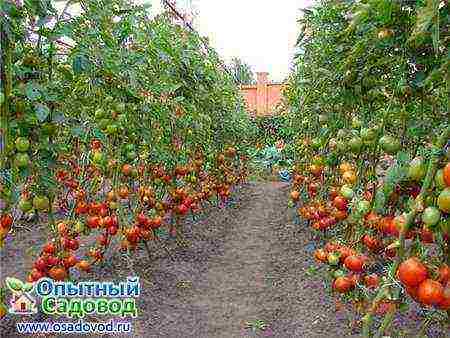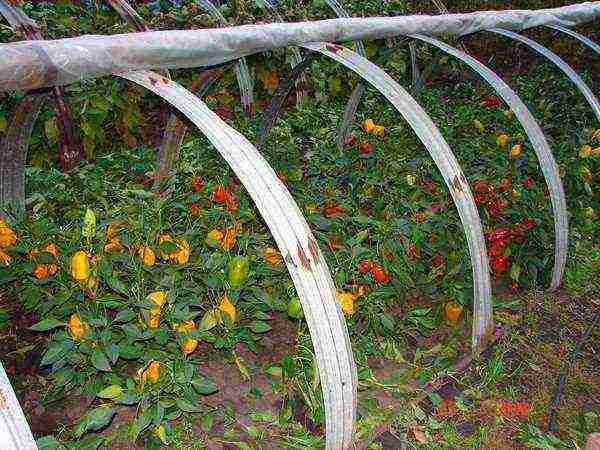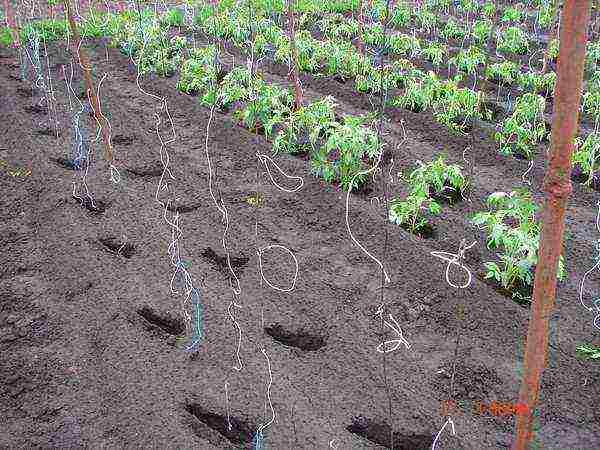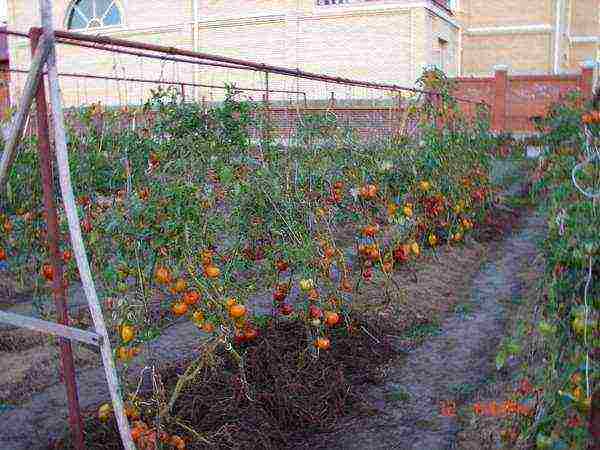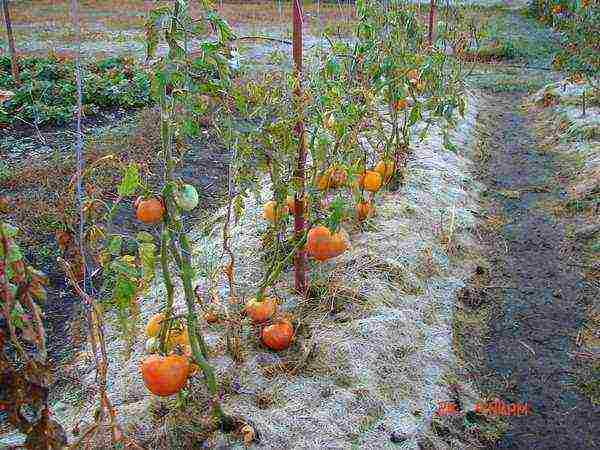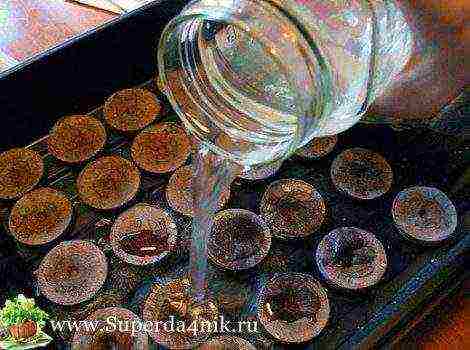Content
- 1 In the open field
- 2 In the greenhouse
- 3 Variety or hybrid
- 4 Unusual tomatoes
- 5 Low-growing tomatoes for open ground. Low-growing tomatoes that do not require pinching. Yielding low-growing tomatoes
- 6 The best varieties of tomato for open ground. Popular varieties of tomatoes for open ground
- 7 What are the best tomato seeds for outdoor use?
- 8 Good harvest tomato outdoors
- 9 Hello dear friends!
- 10 Preparing the soil for tomato princes
- 11 Growing tomatoes in the open field
- 12 Getting started disembarking
- 13 How to tie tomatoes
- 14 Care when growing tomatoes in the open field
- 15 Mini bushes: what are their advantages
- 16 Tomato varieties for open ground (video)
- 17 The best varieties for open ground
- 18 Open field tomatoes in Siberia (video)
- 19 Growing tomatoes in the beds: gardeners' secrets
9 March 2017
ditim
Views: 1101
Decide on the choice which variety of tomatoes is better to plant, not so easy. After all, 2,414 varieties and hybrids are registered in the State Register alone, and there are more than 4,000 of them all over the world. When choosing a variety for cultivation, you need to take into account many factors:
- Ripening period (early, mid-ripening, late-ripening tomatoes),
- Growth type (short, determinate or tall, determinate),
- Size, shape, color of the fruit,
- Variety or hybrid,
- Growing method (greenhouses or open ground),
- Disease resistance,
- Purpose of use (fresh consumption, for conservation, for long-term storage, for making juice).
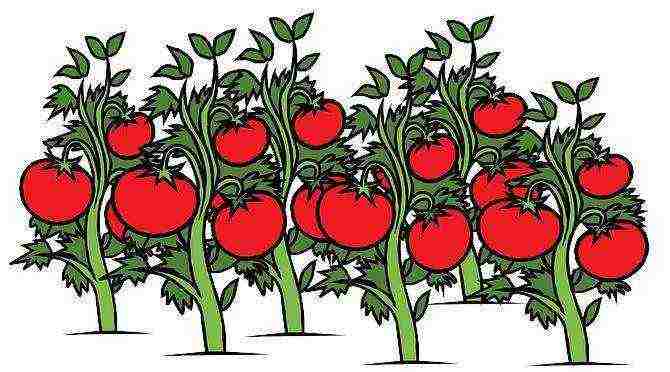
In the open field
In this section, you can combine three selection criteria at once: ripening period, growing method, type of plant growth.
In the open field, it is recommended to plant early or mid-season undersized (determinant) varieties and hybrids of tomatoes. The explanation is simple. By the type of growth of the bush, tomatoes are divided into two groups:
- Shrub - undersized, determinant.
- Liana - tall, indeterminate.
Bush-type plants, in addition to the main stem, have several lateral shoots. All of them, like the main one, end with an inflorescence. The height of such a bush ranges from 60 to 180 cm. The growth of the bush ends when several flower brushes are formed on it.
Liana tomatoes have unlimited growth, they can only grow in length, and endlessly. The onset of frost stops their growth, when a cold snap causes the end of the growing season. In determinant plants, stepchildren are formed not from the stem, but from the pahuzi of the leaf closest to the apical brush. A long liana is formed, about 2 meters high. It is worth noting that this type of plant has a slower flowering rate. There are fewer fruits than those of undersized varieties, but they are much better quality, large and tasty.
So, liana tomatoes in conditions Middle belt, Moscow region, North-West, Urals and Siberia will have time to reveal their potential only in greenhouses. In the open field, they simply do not have enough heat and time.By August, they will be able to form a sufficient number of brushes, but late blight will come and, there is a great risk, it will ruin the harvest.
But the determinant low-growing tomatoes, and the EARLY ripening period, are the best suited for open ground. By August, they will have time to reveal their potential and it will be possible to harvest a good, high-quality harvest. therefore in the open field it is best to plant low-growing bush varieties of tomatoes (tomato).
Early ripe:
- Yamal, the Far North.
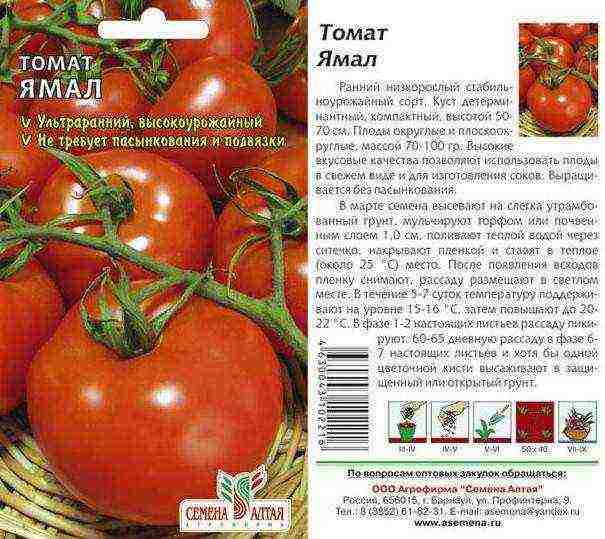
Standard (do not require pinching and have a compact bush):
- Amur bole and Penguin, Otradny and Moskvich.
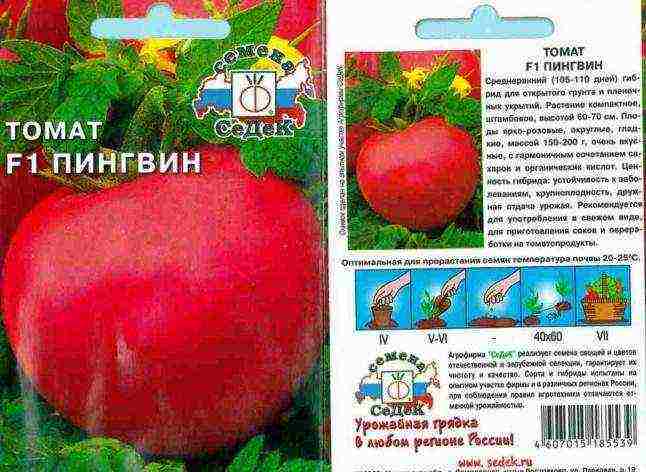
Varieties for open ground in Siberia:
- Oak, May early, White filling-241, Apples in the snow, De Barao.
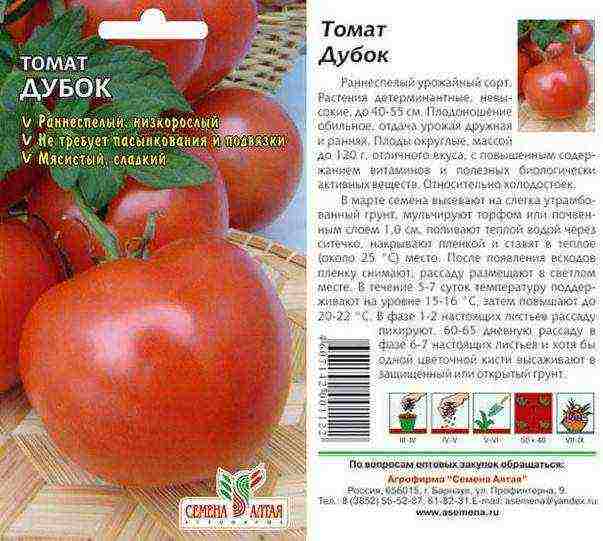

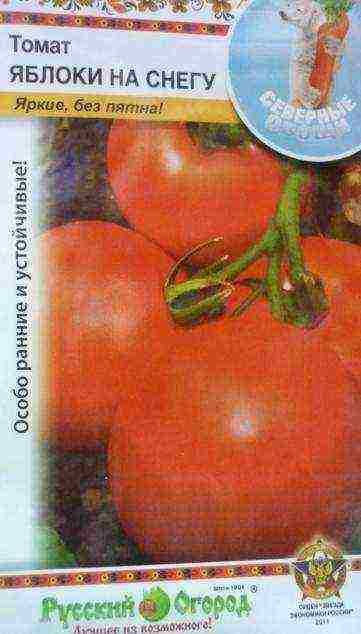
Early ripening varieties for open ground:
- Snow queen, Snowdrop, Spring drops, Bullfinch.
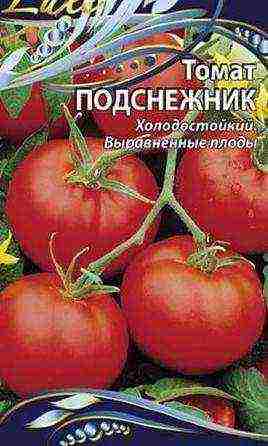
For salting and pickling:
- Rio Grande, Rio Fuega, Maroussia.
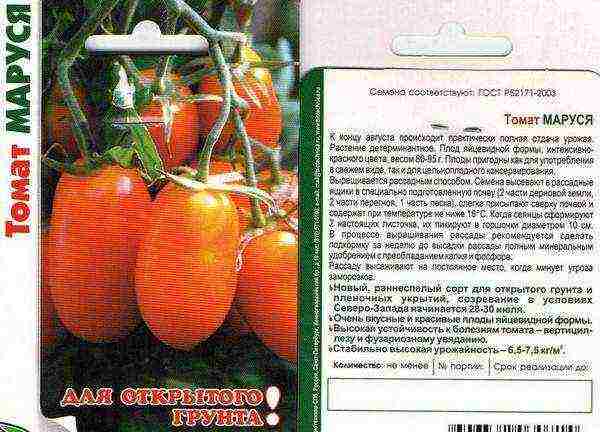
In the greenhouse
But in greenhouses for liana-shaped tall varieties of tomatoes - grace. For the most part, these are not varieties, but hybrids, in which the breeders have put the best qualities. But they are also more capricious. therefore indeterminate (tall) varieties are best planted in a greenhouse... And let the low-growing tomatoes grow beautifully on the street, and without them it is cramped in the greenhouse
Greenhouse varieties in Siberia:
- De Barao and Olya F1 (determinant but good for greenhouses),
- Verlioka F1 (medium-sized and productive),
- Jubilee Tarasenko and Cosmonaut Volkov (mid-season indeterminate salad varieties).
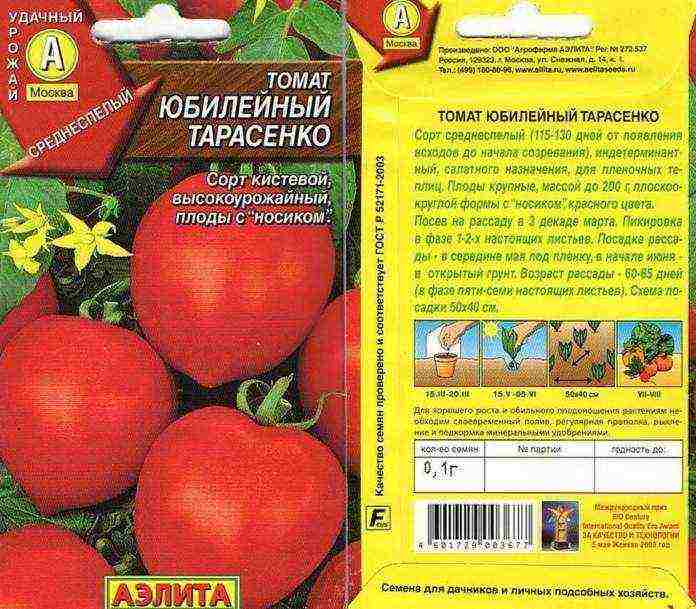
Tall large-fruited tomatoes:
- Giant red, pink, Mikado, Giant Novikov, Semipalatinsky, Bull heart.
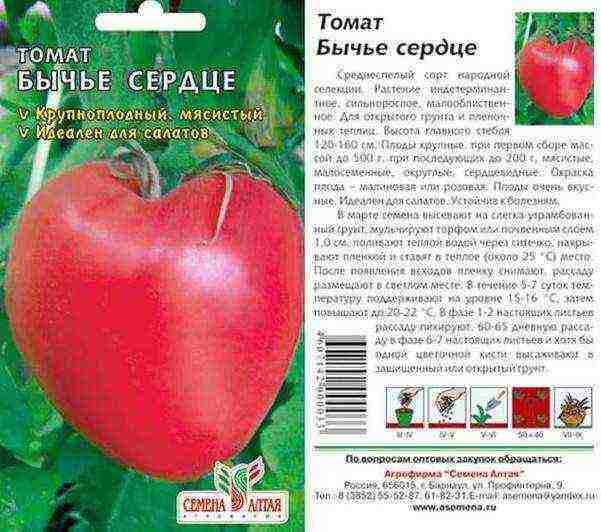
Early maturing indeterminate hybrids:
- Nastya is sweet, Paradise candy, Children's joy, Sweet girl.
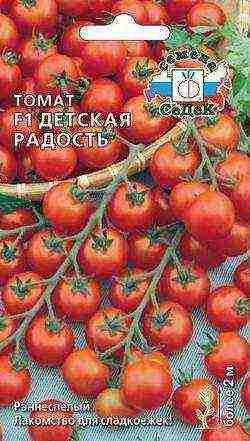

Variety or hybrid
A huge number of varieties and hybrids of tomatoes have been bred, among those and others there are good and bad ones. The quality of the crop does not depend in any way on whether a variety or a hybrid was planted. The fundamental difference between these concepts is that seeds can be harvested from varietal tomatoes, and excellent tomatoes can be grown from them the next year. It is impossible to get seeds from hybrids. No, of course, you can take a good, high-quality tomato, prepare seeds from it, plant it. But ... nothing good will grow. In the second generation, hybrids are destroying traits, dividing them into male and female lines. As a result, you can get a crop of disgusting quality, completely different specimens.
Unusual tomatoes
For those gardeners who are tired of the monotony, want to try something new and surprise guests at the festive table, amazing varieties of tomatoes have been bred. It is possible to grow them in greenhouses in the conditions of the Central belt or Siberia. This is not exotic, as it might seem at first glance. It's just that these varieties have an unusual shape, color or taste.
- Moscow delicacy - pepper-shaped tomato,
- Varieties Tigrovy and Tigris - striped,
- Grouse - tomatoes that look like watermelon,
- Emerald Apple, Jade Gem F1, Emerald Gem F1 - Green Tomatoes,
- Black Prince - tomatoes with a black and raspberry color, outwardly similar to olives,
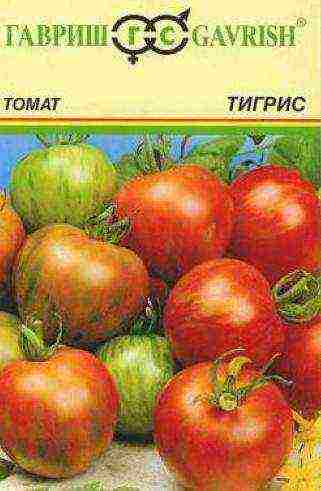
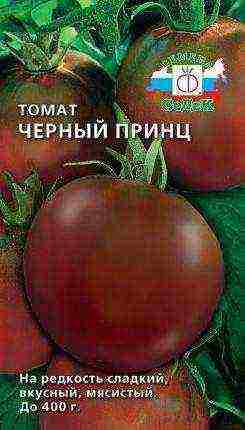
- Peach - Creamy orange tomatoes, reminiscent of a peach.
- Budenovka - large pink heart-shaped tomatoes.
- Yellow ball and F1 Honey candy - yellow tomatoes in ripeness stage,
- Banana orange and Banana red - banana-shaped tomatoes,
- Khokhloma and Chukhloma - elongated red tomatoes,
- Lotus, Snowball, Snow White, Marshmallow and White Sugar - white-fruited tomatoes,

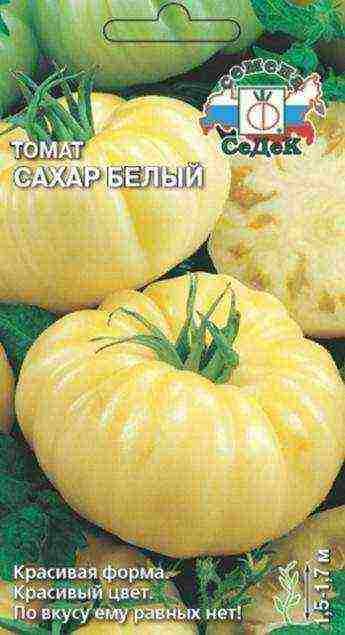
- Swamp - fruits of brown color with pinkish-yellow-brown blotches, but very tasty,
- F1 chocolate - dark brown tomatoes,
- Pepper striped - the name speaks for itself,
- Louis 17 - pear-shaped fruits,
- Don Quixote F1 - cuboid fruit shape,
- Maroussia is an egg-shaped (plum-shaped) fruit for open ground,
- Grape, Cherry red and Cherry yellow - small-fruited tomatoes,
- Yellow caramel F1 and red caramel F1 - they resemble sweet cherries in shape, and caramel in taste.
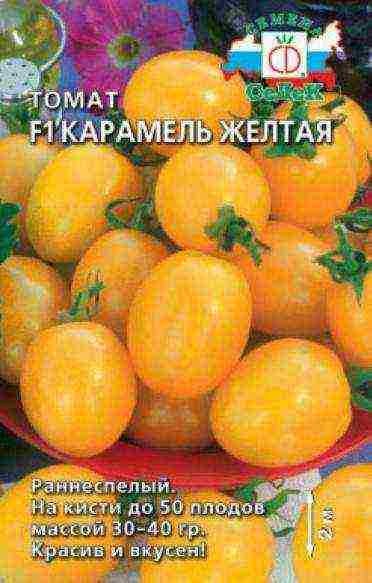
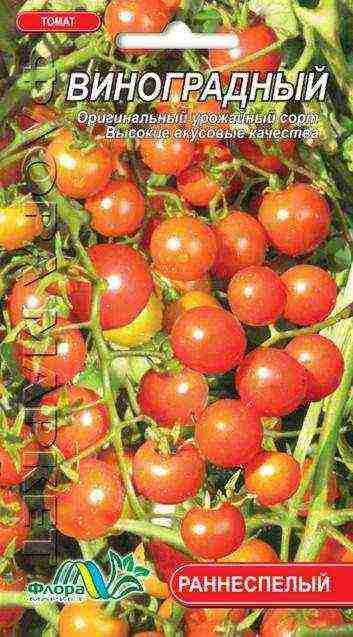
The next article will be devoted to varieties resistant to a particular disease. There are many such varieties and hybrids, and they require more detailed consideration.
Low-growing tomatoes for open ground. Low-growing tomatoes that do not require pinching. Yielding low-growing tomatoes
Getting a good harvest in a short time is not easy. Specially bred low-growing tomatoes for open ground will help with this. Today there is a huge variety of varieties.
Open field tomatoes
"Watercolor". An early variety (3 months), the height of the standard bush is 50 cm, the seedlings do not stretch. Fruits are elongated, red (90-110 g) with a dense skin. They have good keeping quality and excellent taste, which are not lost after ripening. The variety is intended for canning and fresh consumption, resistant to top rot and septoria.
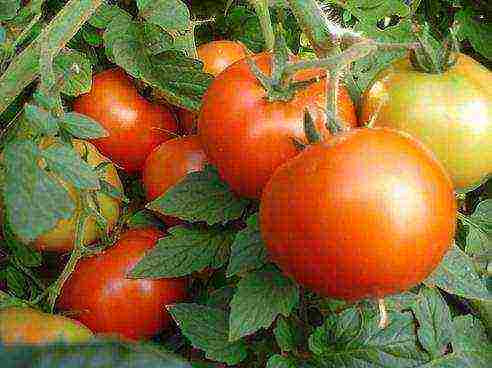
"Supermodel". Medium early variety with fruits up to 10-12 cm long. Standard bush 60-75 cm high. Fruits of a raspberry hue, moderately dense, weighing 120 g. Suitable for pickling and preservation.
"El Dorado". A productive variety with oval-heart-shaped fruits of yellow-lemon color, weighing 200-250 g. The height of the standard bush is 50-80 cm.
"Skorospelka". The height of the bush is 60 cm. The shape of the fruit is flat-round, red color, weight 170-200 gr. Differs in unpretentiousness, early return of the harvest, excellent fruit set at low temperatures.
Golden Stream. A plant that is resistant to temperature extremes. A very early variety with bright orange, smooth fruits, weighing 100 g, elongated elliptical shape. Differs in good productivity and resistance to many diseases.
Red Fang. The ultra-early ripening variety is simply strewn with red shiny finger-shaped fruits weighing 40 g. Designed for canning and fresh consumption. The bush is 90 cm high.
The above-mentioned low-growing tomatoes, which do not require pinching, ripen quickly enough, which allows them to avoid late blight disease.
What kind of tomatoes are grown outdoors?
The main difference between undersized and early ripening varieties is the low location of the first flower cluster - above 4-5 true leaves. Adjacent inflorescences can be located one after the other. Or be separated by one sheet. The growth of the bush is limited to a flower brush.
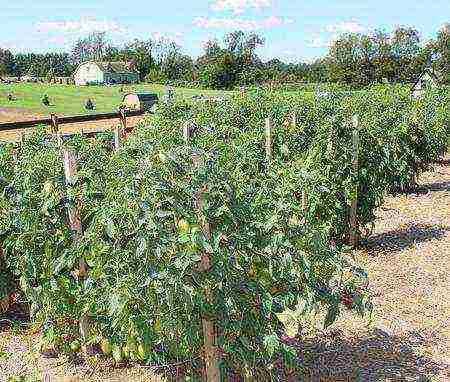
Low-growing tomatoes for open ground have time to give the crop before the onset of cold rains. Unripe tomatoes ripen well in boxes. Superdeterminate undersized tomatoes for open ground have a short fruiting period. Their fruits are medium-sized, weighing up to 100 grams, mainly for canning purposes.
Determinant varieties can be grown in the same way. They differ in greater height - up to 1 meter and require a garter to the support. The first flower brush is located above the 5th leaf. Fruits are larger - up to 200 g. Inflorescences are separated by one or two leaves. These undersized outdoor tomatoes are of the restricted growth type.
Landing dates
In open ground, low-growing tomatoes that do not require pinching are planted at different times - depending on the region. So, in the southern regions - on the fifteenth of May, in the middle lane - at the beginning of June. In northern latitudes, planting is carried out when the daytime positive temperatures are 14-15 degrees, and the threat of night frosts has passed - on June 10-15.
Soil preparation
Low-growing tomatoes that do not require pinching feel good on loamy and sandy loamy soils, rich in humus, with a neutral reaction.
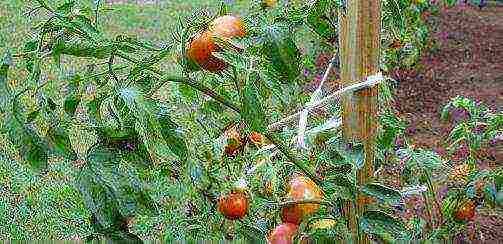
The ridges are located in well-warmed and protected from the wind places. In one place, tomatoes can be grown for no more than 3 years, in order to avoid the accumulation of pests and diseases in the soil. Good prior crops are cabbage, onions, courgettes, carrots.Tomatoes cannot be grown after peppers, potatoes, eggplants, physalis, since they belong to the nightshade family and have the same pests and the same diseases.
For early low-growing tomatoes, fresh manure is not applied, which contains a lot of nitrogen and allows you to build up a large amount of green mass to the detriment of fruiting. Therefore, from organic fertilizers, only humus is permissible - a bucket for 2-3 holes. Mineral complex fertilizers (for example, nitrophoska) are applied in the spring for digging.
Low-yielding tomatoes prefer medium-heavy soils. Therefore, clay and peat are added to the sandy soil. This makes it more cohesive and better at retaining moisture. In clay soils, on the contrary, sand, rotted sawdust or leaves, peat are added.
Before digging, the soil is spilled with copper sulfate (1 tbsp. L. Per bucket of water) at the rate of 2 liters per square meter. Ridges for tomatoes are made low so that water does not drain from them when watering.
Transplanting
Plants are placed in a checkerboard pattern or with ribbons. The feeding area for early tomatoes is 30 x 40 cm, for mid-ripening ones - 50 x 50 cm.
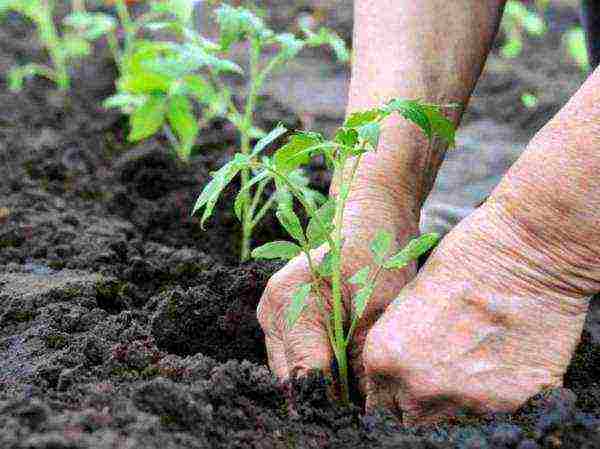
Wells with a diameter of 30 cm after the introduction of humus are spilled with a pink solution of potassium permanganate and not overgrown seedlings are planted without deepening. For overgrown seedlings, it is permissible up to 10-15 cm with the removal of one or two leaves. With the deepened method, the loss of fruits from the first brush is possible if it has already gained color.
For prevention, it is advisable to treat seedlings with Bordeaux liquid before planting, which is produced in cloudy weather or in the evening. If the sun suddenly appears, the seedlings are covered with a non-woven covering material on top to create shade.
The plant should be 30 cm tall, have a stem thickness of 0.8-1 cm, 7-8 leaves and one brush that has gained color. After planting, it is better to mulch the soil - this will protect it from drying out and cracking. For this, humus, rotted sawdust, last year's dry leaves or straw can be used.
For the middle lane, the ripening dates of tomatoes in the open field are assumed to be from July 15 (early) and August 5 (mid-season).
Harvest tomatoes
Low-growing tomatoes without pinching varieties "rocker", "baskak", "betta", "boni m", etc. give 2-3 kg of fruit per plant. They are distinguished by the early return of the harvest and the ripening of tomatoes on the bush.
In addition to varieties with fruits for canning purposes, today you can buy large-fruited salad.

For example, low-growing tomatoes without pinching of the "Friday F1" variety reach a weight of 220 g, "tourmaline" - 160-180 g, "Russian tasty" - 300 g. Productivity, respectively, 5, 4, 6 kg from one bush.
Large-fruited varieties
A common misconception is that early ripening, short tomatoes can only have small fruits. But the best varieties of stunted tomatoes prove that this is not the case.
Fat Jack. An early powerful variety 60 cm high. Fleshy, sweet, red fruits weighing 250 g have high taste and good keeping quality. Plants are unpretentious to growing conditions.
Low-growing early ripening tomatoes are also represented by the "darling" variety. Plant height 60 cm. Fruits are round, smooth, weighing 150 g, do not crack, for salad purposes. Plants tolerate drought and a slight cold snap. Fruits can be set in not very favorable conditions.
"Mirage". Another large-fruited variety with spreading bushes 60 cm high. Red fruits of a flat-round shape of good taste weighing 250-270 g.
"Knight". Perhaps the best variety, medium early, unusually productive. The height of the bush is 65 cm. Fleshy fruits weighing 250 g, reach 300 g at the beginning of fruiting.
"Visibly invisible." An early ripe tomato 50 cm high is strewn with homogeneous red fruits weighing 130-150 g. Resistant to fungal diseases.
"Honey A". Very interesting cherry tomato undersized. It is grown both outdoors and in a pot in an apartment, and on a balcony, and even in a hanging container.It develops a compact standard-shaped bush and many bright red, sweet fruits.
Care
All activities are reduced to timely loosening, watering, fertilizing and disease prevention.
If the beds with tomatoes are mulched, then loosening is not required - only the removal of rare weeds. Watering in this case can also be reduced - the soil will not crack and moisture will evaporate less.

Providing tomatoes with sufficient water is a prerequisite for a high yield. Plants are watered between rows or at the root every five to seven days. The soil should be moistened to the depth of the main roots - 30-40 cm. It should be remembered that uneven watering contributes to the cracking of the fruit.
Top dressing
During the growing season, fertilization will be required in a dissolved form. The first feeding is carried out half a month after planting seedlings in the ground. For this, a fertilizer consisting of phosphorus and potassium is used. The second top dressing is done with a full complex fertilizer (nitrophoska) a month after the first. The third consists of potassium and nitrogen for the early ripening of fruits and is carried out a month after the second, in mid-August.
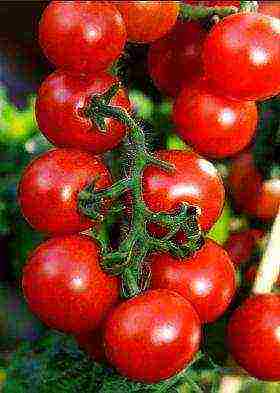
For the formation of ovaries during flowering, you can spray the flowers with this solution: 1 g of boric acid and 1 tsp. baking soda for 1 liter of water.
Tomatoes also respond well to foliar feeding with microelements twice a season.
Root dressing is best combined with watering. First, lightly saturate the ground with water. Then add a solution of fertilizers, and after feeding, water again. Once a month, you can add a little potassium permanganate to the water. Such watering is the prevention of late blight, increases the sugar content of the fruits and ripening occurs faster.
Signs of starvation in tomatoes
If the plant lacks nitrogen, then the leaves become light green, pale. Lack of phosphorus is expressed by the appearance of a purple shade of the leaves or the lower part of the stem. If the plant begins to dry out, then you need to urgently feed with potassium. Twisted leaves indicate that you need to add potassium and nitrogen.
How does excess fertilizer affect?
With excessive nitrogen, the plant will intensively increase the green mass ("fatten"), there will be no flowering. An excess of phosphorus fertilizers will lead to the fall of flowers and ovaries, yellowing of the leaves. Excessive potassium is expressed in the appearance of dull spots.
The best varieties of tomato for open ground. Popular varieties of tomatoes for open ground
It is no secret that tomatoes contain biologically active substances in abundance. They are able to normalize the acidity of the intestines and contribute to the rejuvenation of the cells of the body. The reason is that, as powerful antioxidants, tomatoes neutralize free radicals.
Which varieties should you choose?
Today there are many varieties of superior quality tomatoes. Let's not forget that in translation from Italian the word “tomato” means “golden apple”. Sometimes it is also called a country orange. The fact is that in terms of the amount of vitamin C, tomatoes are not inferior to citrus fruits. One large fruit contains the daily requirement of this vitamin! Here are the names of just some varieties of tomatoes:
- "Anyuta";
- "alpha";
- "Bull heart";
- "Andromeda";
- "Admiralty";
- "Neva";
- "jewel";
- "Siberian early ripening";
- "rocket";
- De barao.
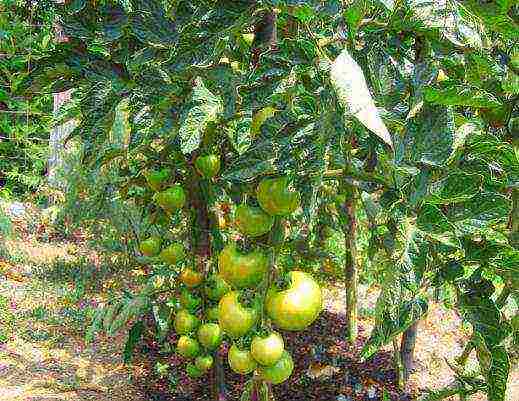
At the same time, both professionals and amateurs are convinced that the best varieties of tomatoes for open ground are those that have a ripening period of about 90 days. That is, they ripen for about 3 months.
Tomato varieties for open ground
Each of the named varieties naturally has its own characteristics. Some of them are universal - suitable for both open ground and greenhouses. But there are varieties that are designed specifically for the street. These tomatoes are distinguished by the fact that the seedlings are not so strongly exposed to the cold and can survive the slight frosts that often occur in early spring.
Here are the best varieties of tomato for open ground: "Anyuta", "Alpha", "Riddle", "Anastasia", "Fruitful", "Raspberry Giant", "Roma" and others, which we will talk about below.
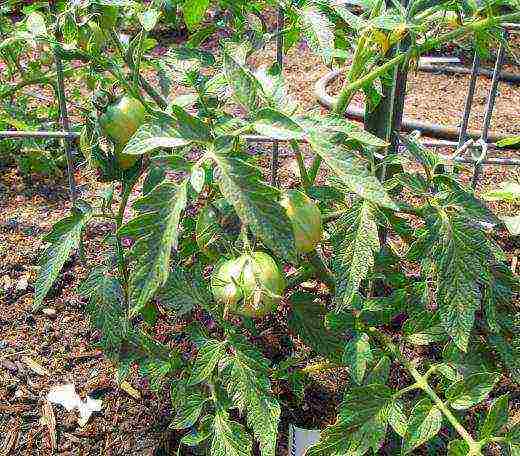
All of these species are characterized by high resistance to various kinds of diseases. At the same time, the mass of one tomato reaches 200 g. In addition, they all have excellent taste. But this is subject to proper care. Without human care, even the best tomatoes can go to waste.
Features of different varieties
When listing the best varieties of tomato for open ground, one cannot fail to mention the following: "riddle" and "raspberry giant". Let's start with the first one. The Riddle is an early breed. This type is distinguished by smooth fruits with a dense skin. Mid-early varieties include the "raspberry giant". Its peculiarity is sweet fruits of large size and flattened shape.
Some varieties are short, others, on the contrary, are tall. In particular, tomatoes from Holland "rum", although they have relatively small fruits, yet yield up to 20 tomatoes from one bush, the height of which can reach 0.5 m.
Tomatoes. The best varieties for the Moscow region
This category includes, first of all, three varieties: "anyuta", "alpha" and "sanka". They are best suited for climatic and soil conditions in the Moscow region.
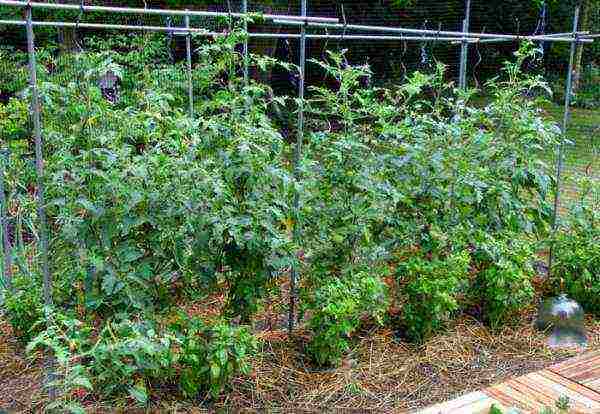
"Sanka" is considered to be super early maturing and undersized. Ripening occurs in three months, the height of the bush is 0.6 meters. The fruits have a pronounced characteristic color and high juiciness, as well as excellent taste. This variety can be eaten fresh or canned.
"Anyuta" ripens early, the fruits are red. No yellow-green spot next to the stem. The variety is not susceptible to diseases such as tobacco mosaic, Alternaria and Fusarium. On the open ground, you can collect about 9 kg / m2.
Another species that falls into the category “Tomatoes. The best varieties for the Moscow region "-" alpha ". It also bears fruit in about three months and can be grown without stumps (non-seedling method). The height of the bush is 40-50 cm. Since tomatoes ripen early enough, there is no threat of late blight. Due to its excellent taste, the variety is recommended to be consumed fresh.
Description of tomato varieties with photos
Below we briefly describe a number of tomatoes. Thanks to the photo, you will be able to further accurately distinguish these species from others. In addition, we describe the varieties of tomatoes, the reviews of which are impeccable.
Let's start with tomatoes that ripen early.
- Variety "Eugenia" (see photo below) is grown outdoors. It is used for preservation, and is also suitable for salads. Drought tolerant. The bushes have small, dark colored leaves. Fruits are strong and with an even surface. "Evgeniya" allows you to get a large amount of harvest even in unfavorable weather.

- Aurora F1 is also suitable for adding to salads and for preserving. It can also be grown outdoors. Sheets are medium in size. Fruit weight reaches 110 grams.
- Variety "red sun" F1 is also grown both on the street and in the greenhouse. The tomatoes are delicious, weighing about 120 grams.
- Grade "Admiral" F1. Can be eaten fresh and canned. Tastes great. It is resistant to disease. The fruits are bright in color, there are almost no ribs.
- Variety "spring drops". Considered overripe. It tolerates cold well, gives a very reliable harvest.
- "Dandy" grade F1. Can be considered a salad. Produces round and dense tomatoes weighing more than 100 grams. The tomatoes are delicious. Resistant to diseases and bad weather.
- Variety "harmony". Gives a wonderful harvest. The bushes have medium leaves and not too much branching. Fruits are even red in color, taste good. The variety has a very high marketability.
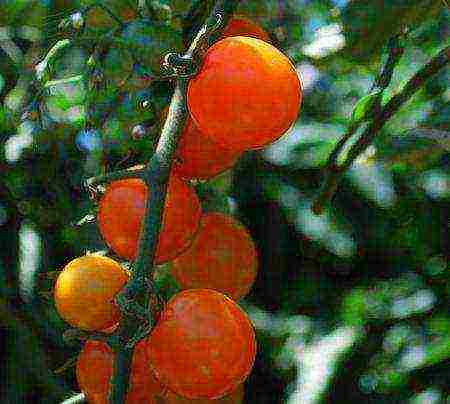
Pink varieties
Many people prefer to eat pink tomatoes, as they have a special and unique taste. These are sweet varieties of tomatoes:
- Demidov. Produces fruits up to 200 g. Stable fruiting. Very suitable for outdoor cultivation.
- "Pink Raffaello".Gives round tomatoes weighing about one hundred and fifty grams. Has a special taste.
- "Supermodel". Fruits in tomatoes with a flat surface and rich color.
Growing without film
And now we will give examples of varieties suitable only for open ground:
- Scarlet Mustang. Grown without a film. Produces large, robust tomatoes.
- "Carotene". Gives tomatoes orange, round, and they are very high in carotene.
- "Laura". The variety is mid-season. Can be used in salads or canned. Oval-shaped tomatoes with sweet pulp.
- "Scheherazade" - looks like a peach. Produces red tomatoes with a characteristic edge. The fruits are cylindrical in shape and weigh up to 300 grams. The taste is specific, the acid is not felt. The bushes reach 1.8 meters in height. There is a high disease resistance.
- Sort "stellate sturgeon". Height - up to 120 cm. Tomatoes are raspberry-colored, shaped like a heart. The fruits are very large - weighing up to one kilogram. The variety is very unpretentious, the first harvest is harvested together with early ripening tomatoes.
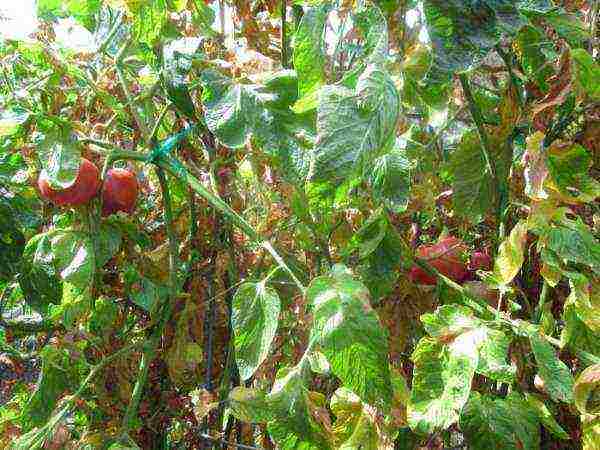
Tall tomatoes
Tall varieties of tomatoes are also called indeterminate. Some of them have been described above. This type of tomato has a number of advantages over their undersized counterparts. No wonder the breeders tried to bring out just such powerful bushes.
The undoubted advantages include an increase in the number of fruiting brushes of a plant due to its vertical arrangement. Thanks to this, the harvest can be sixteen kilograms per square meter!
In addition, the plant is evenly illuminated, and the full access of air to it makes it possible to achieve high resistance to various kinds of diseases. It is also important that tall varieties ripen later than undersized ones - from about July to the first frost.
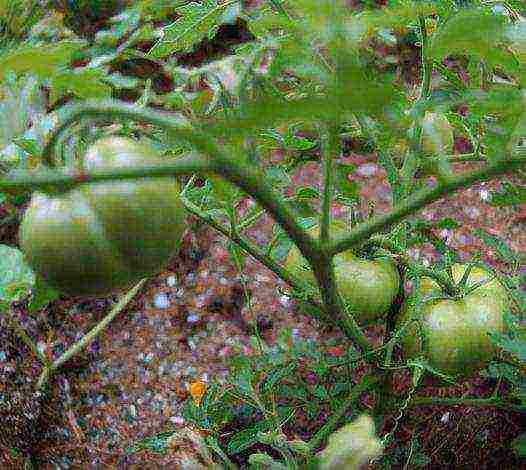
In addition, such tomatoes are much easier to care for. It is necessary to leave only one stem, breaking off all the shoots around it. All varieties of tomatoes with a height of more than a meter can be considered tall.
They also have a drawback - a garter. This action requires the installation of a rope or pegs on which the bush will rest. Under no circumstances should the trunk be allowed to lie on the ground.
Disease-free tomatoes
What varieties of tomatoes are resistant? These are early ripening plants, which, due to the high rate of maturation, simply do not have time to be exposed to the pathogenic phytophthora. The latter means a fungal disease that develops at temperatures below fifteen degrees Celsius with high humidity. Since spores are usually carried from potatoes, tomatoes should be planted as far away from the crop as possible.
There are many ways to combat tomato diseases - both folk and scientific. But the best and most reliable is still to grow early ripening varieties, or at least combine them with the later ones, which were discussed a little higher. Such a variety in the beds guarantees you a harvest, regardless of the vagaries of spring or summer weather.
It's important to understand that even the best outdoor tomato varieties can be disappointing. Inadequate care, lack of standard prevention, irregular watering - all this leads to the fact that even the strongest and hardiest tomatoes get sick and wither.
What are the best tomato seeds for outdoor use?
Who among the gardeners does not want to grow a good tomato harvest with the minimum expenditure of their efforts and time? And this is a very solvable task. The main thing is to choose the right tomato seeds for open ground among the early ripening varieties of this vegetable.
The best tomato seeds for open ground are the Cipollino variety, which is very fruitful. The bush is covered with numerous fruits. From one square meter, you can get up to ten kilograms of early tomatoes.
Also good yields are early tomatoes for open ground "Amurskiy Shtamb", Penguin "and" Beta Lux ", which are characterized by low growth and the ability to give a guaranteed yield in any region of the country, since these varieties of tomatoes have time to ripen before late blight outbreaks. In addition, the varieties Azhur and Kukla, which are also intended for cultivation in the open field, have proven themselves well.
The second point not on the way to achieve this goal is the time of sowing seeds. The most optimal time to plant tomato seeds for open ground is the end of February, since early sowing makes it possible to get an early harvest. After the seedlings have appeared, they should be transplanted. A paper cup is suitable for this. After a few weeks, it is necessary to harden the seedlings.
To do this, you can take it out to the balcony for a few minutes, and then the pause should be gradually increased. Seedlings are hardened for about three weeks. This is done in order to increase the plant's resistance to low temperatures.
Tomato seeds for open ground can be sown directly into nutrient pots, that is, without picking. This is due to the fact that, as a rule, seeds of varieties that are accustomed to open ground and varieties of folk selection that are not sufficiently resistant to various viral diseases are used for sowing. By transplanting them from place to place, it is possible to allow the breaking off of small roots, and an infection can penetrate into the resulting wounds of completely healthy plants.
Sowing without picking, as a rule, is carried out only for low-growing varieties intended for planting in open ground.
Caring for seedlings of such tomatoes is an extremely crucial moment. Before planting in the breast, tomato seedlings should be about two months old. In addition, at the time of planting tomatoes on beds in open ground, care should be taken that the plants are strong, have from nine to twelve leaves and are not too elongated due to lack of light. Proper watering of the seedlings is considered a prerequisite.
Watering is carried out once a week at the beginning of growth, using half a glass per tomato root. When more than three leaves appear per plant, about one glass of water should be consumed.
Plants are fed every two weeks. The first time it is carried out twelve days after the appearance of the first shoots. Top dressing is done on the basis of a nitrophoska solution - one tablespoon of fertilizer is taken for ten liters of water, with the calculation of the consumption of half a glass for one tomato.
The second time early tomatoes are fed ten days after the first fertilization. This will require fertilizer "Effecton", which is prepared in the proportion of a tablespoon of the drug per bucket of water, only with a glass consumption per plant.
The best tomatoes for open ground can be obtained when the third feeding is done, which is carried out a few days before planting the plants in open ground. You should be aware that all fertilizing should be carried out in moist soil after watering.
If you strictly adhere to all of the above instructions, you can be guaranteed to get a bountiful harvest of excellent tomatoes that can decorate your feast.
Good harvest tomato outdoors
How to grow tomatoes in the open field in your country house?
|
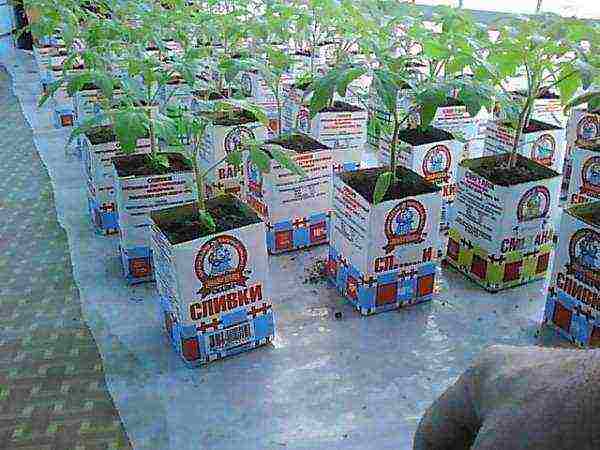
Several years ago I made a choice for myself how to grow tomatoes in my summer cottage. Since then, despite the harsh climate in Altai, I have given up using greenhouses and place these vegetables only in the open field.
Since I harvest tomato seeds mainly myself, I don't use hybrids. My main varieties now are Russian Bogatyr, Altai Masterpiece, King London, Northern Beauty, Fat Jack, Snezhana, Sevryuga. Only 2-3 new varieties I test every year, and if the variety is suitable - I leave it to myself for constant use.
I choose a place for tomatoes in the fall so that the predecessors are carrots or onions, and I also strictly follow that they would not be there for 3-4 years earlier. Tomato beds 5 m long are evenly covered with humus of bird droppings of 3-4 kg and I leave it like that until spring.
I sow seedlings in early April, because my apartment and loggia are very sunny, and the tomatoes grow very actively and quickly, and if they are sown earlier, they simply outgrow. I use my garden soil with the addition of a quarter of peat. I plant the seeds to a depth. 1-1.5 cm.
I plant seedlings in the ground on May 15-20. Immediately I install metal arches on the beds, and on them I fix a non-woven covering material. It protects young tomatoes well from the sun, and from the wind, and from frost. If the frost is very strong, I additionally cover the beds from above and polyethylene. These chores continue until June 15, and then the tomatoes grow constantly openly.
All summer I weed the beds, regularly water 2-3 times a week, constantly loosen. Twice a season in June and July I feed with a solution of bird droppings 1 to 15 at the rate of one bucket of 10-12 bushes. This gives a very good effect, the bushes grow very strong, powerful, bloom well and give many ovaries.
I tie tall, indeterminate varieties (some reach 2.5 m) to the pegs and form them into two stems, removing all the stepchildren. I do not tie determinant tomatoes at all, but I fill their beds with pine needles and they grow lying down. This does not really affect the yield, but the fruits are clean due to the needles and do not deteriorate at all.
In September, the bushes of late varieties are untied from the pegs and laid out along the beds, and again I put arcs and covering material to protect them from autumn frosts. Thus, fruiting lasts until mid-October. I also do this for stagnant varieties (Severnaya Krasavitsa, Pepper, etc.) ...
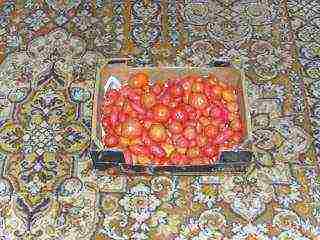
Your tomatoes for the new year
Some of them can keep good quality of fruits until the new year. They may not look as beautiful in December as in summer, but they have good taste and are 100 percent ecological!
How to grow delicious tomatoes
Peter Muranov from the Penza region shared his experience on how to grow delicious tomatoes.
“I grow tomatoes in an unheated lean-to greenhouse 6 m long and 2.5 m wide. Its northern side is dull, whitewashed from the inside. The front and side walls are covered with non-woven fabric, the roof is covered with plastic wrap. For ventilation, vents are made in the sidewalls. I make the beds for growing delicious tomatoes high - 0.8 m, 1 m wide.
I plant determinant varieties of tomatoes Golden Heart and Gnome (30 roots in total). These are fruitful tomatoes, which, moreover, are practically not affected by late blight. For a change, I also grow 10 plants of varieties Carrot, Truffle and some others.
I plant tomato seedlings sown in March in a greenhouse in mid-May, deepening the plants by two-thirds. How to grow delicious tomatoes next? Here, a lot depends on the dressing.
A week later, and then every three weeks I water the seedlings at the root (1 liter each), alternating infusions for feeding - mullein (1: 10), biostimulator Ovary (according to the instructions), ash (glass), double superphosphate (half a matchbox) and nitroammofosk (1 matchbox).
For the prevention of viral diseases, I give tomatoes a solution of potassium permanganate (0.5 g) and boric acid (35 g).
There is another secret on how to grow sweet tomatoes. For the sugar content of the fruit, there is a proven composition of feeding -1 tbsp. a spoonful of table salt and 1 glass of ash.
If it rains for a long time, then I use Fitosporin, and in the heat, when the tomatoes are poorly pollinated and their flowers crumble, I water it with a solution of boric acid (1 teaspoon).
All infusions and solutions are prepared per 10 liters of water.
With such care, the harvest from 40 roots of tomatoes is enough to provide yourself with fresh vegetables and make preparations for the winter. "
Everything about tomatoes.
from Lydia Ishimtseva.
I have been engaged in vegetable growing for about 30 years. During this time I came to the conclusion that labor on the ground is creativity, however, hard. But in order to create, you need to know about the factors affecting the development of plants in order to get a good harvest in any weather conditions. My hobby is tomatoes.Over the years of growing this crop, I have come to the conclusion that not only heat, light, air, nutrition are decisive factors.
Choosing the right variety is very important when growing tomatoes in the open field, and in a greenhouse. For the northern regions, cold-resistant early maturing varieties are of the greatest value. Many gardeners make a gross mistake by growing varieties that are not adapted to local conditions, or rather, sow what comes under their hands, more often southern varieties, hence all the failures, and after failures and disappointments.
In a previously published article on tomato varieties, I wrote that my rule is never to offer seeds of those varieties that I have not grown and that I have not tasted. So this year there were about 50 "new varieties". I selected 28. Many varieties were sent by amateur gardeners from the Tyumen region, Novosibirsk, Altai Territory.
Thank you, my dears, for the seeds for your care. All of your varieties are truly noteworthy.
The old reliable varieties that I have been growing for many years, which have received good reviews from amateur gardeners, did not fail either. Tomatoes "giant Novikova", "astrakhan", "potato raspberry", "king of London", "pink honey", "South Ural", "hospitable", "Gina", "budenovka", "early 83" - large-fruited, fruitful, this year did not disappoint.
"King of the Early" - one of the best large-fruited varieties for open ground, fruits of light raspberry color, weighing 400 g, tasty. Of the new varieties, or rather those that I planted for the first time, I was struck by the "grandmother's secret" with fleshy sweet fruits up to 800 g - and a lot.
"Pink Elephant" - large, fleshy, sugar at the break. "Scarlet candles" - delicious, good salted.
In the article, O. Simone read about Chinese tomatoes. Seedlings are bought for 30 rubles. per bush.
I sowed the seeds I donated. I saw nothing unusual either. And somehow I did not notice them, and when they began to ripen, a wonderful transformation happened. The bushes were completely covered with strong beautiful tasty tomatoes - 200 grams each. They are stored for a very long time. Well, since they started talking about storing tomatoes, then I bought wonderful "tankin truffles" tomatoes. Stored in a cool place until January, the "Japanese truffle" is orange, does not yield in time, it is stored well, although less.
In my practice, I prefer low-growing varieties for open ground. I got wonderful varieties - “favorite holiday” (fruits of a huge size, deep pink color, height 80 cm), variety “altaechka” - it is all strewn with red-crimson fruits from 150 to 300 gr.
"Tsar's gift" - about this variety wrote an amateur gardener O. Simone. Fruits are pink, large up to 400 gr. This is already a truly "royal gift".
"Destructive Force" is a new high-yielding variety, undersized with large fruits. "Lord Keeper" - a gift for gardeners, pepper-shaped. Very productive. "Pudovik" - undersized with large fruits. I would also like to say about such early ripening early varieties presented to me - "harnas", "lykurich", "rosina", "Siberian trump card" - very early.
"Siberian Troika" is a low-growing high-yielding variety, the fruits are pepper-shaped, very large, red, hanging in clusters.
"Honey Spas" - you can shoot with basins, a kind of sunny amber hearts. Thank you all for sending the seeds.
I'd like to say that of the undersized large varieties, the best is the "Mongolian dwarf". But now I have a "knot", imagine a brood hen with chickens under it. This is how this sort of "kluzha" looks like: "chickens" -tomatoes do not look out from under the leaves, but push them apart, and there are smooth, round, tasty "chickens", there are so many of them.
A very good variety from the same series of undersized "Little Red Riding Hood", "Yamal".
I would like to say especially about the “daddy” variety. There were three seeds. This is a wonderful variety, there are many fruits, hanging in bunches. It seems to me that I collected them all summer, and they all grew and grew.
My dear gardeners! Pay attention to the varieties. Varieties must be adapted to the conditions of a certain zone: cold-resistant and early maturing to the north. "Siberian early ripening", "jewel", "Alaska", "northerner", "Siberian troika", "Siberian trump card", "little red riding hood", "Mongolian dwarf".
Heat-drought-resistant in the south, resistant to a complex of diseases, and possessing gustatory qualities.
Varieties for any purpose must, above all, be characterized by high and stable yields. These are the seeds I want to offer you.
Seeds 15 pieces - 10 rubles.
The minimum order amount is 50 rubles.
A letter from you with an attached receipt (or a copy of it) about the transfer of money, a blank envelope with a stamp of 30 rubles. with your address. My address: 456531, Chelyabinsk region, Sosnovsky district, pos. Sargazy, st. Sirenevaya, 13, apt. 2, Ishimtseva Lidia Iosifovna.
Phones:
8-351-44-99-3-36, 8-919-115-79-04.
Lidia ISHIMTSEVA
Sargazy village
Why not talk about the formation of tomatoes in a greenhouse :? After all, oddly enough, many novice gardeners do not even suspect that tomatoes also need to be formed somehow. They think he planted it - and he grows for himself.
But, since you started growing tomatoes in a greenhouse, it would be more rational to follow all the rules of growing. First, it is better to grow indeterminate varieties and hybrids in greenhouses. These are tomatoes that grow almost indefinitely until the very frost. And it would not be bad at all if they only grew up. But tomato plants have such an interesting feature, they like to grow additional stems, shoots, called stepchildren. Stepsons can grow from each leaf sinus. It is not uncommon for two stepsons to grow from one sinus. And if the tomatoes are properly overfed, then you can see a lot of surprising - stepchildren can form on flower brushes and even directly on the leaves. If you don't fight this, but just walk and water, then in mid-July it will be difficult for you to walk through the greenhouse, and in August it is simply unrealistic.
It would seem, and it is good - how many tomatoes will grow in such a forest - a novice gardener would think. But no, unfortunately it will not grow - there will not be enough food and our short summer. Plus, diseases will overcome, they will be a real resort in such a shade and dampness. So all the energy of the plant, instead of being directed to the formation of a crop that really has time to grow in our conditions, will drive a bunch of green tops and a lot of flowers that few people eat. You are not going to feed the Colorado potato beetle.
For this reason, tomatoes must be formed in the greenhouse.
Growing tomatoes in one stem. The simplest bush formation.
Indeterminate varieties and hybrids of tomatoes are usually formed into one stem. This means that all stepchildren are deleted. And you will have only one main trunk, on which 5-6 brushes of tomatoes should have time to grow by August. In general, this is the simplest type of formation, therefore it is perfect for beginner tomato growers.
Indeterminate tomato varieties yield gradually throughout the summer. The first flower raceme usually forms above 10-11 leaves, and the next ones - after 3 leaves.
See what is written on the bag of your seeds. Usually the seed producer will indicate if the plant forms into a single stem. But sometimes this is not written, they simply indicate that the variety is indeterminate.
Stepsons usually begin their growth no earlier than the first flower brush appears. Right below it, the first, fattest stepson begins to grow. Sometimes it is rational to leave one flower brush on this first stepson and pinch it. At the same time, two more sheets are necessarily left above the brush, and only then they pinch. This is necessary for the full circulation of the juice.
As the plant grows, at least once a week, carefully break out all the stepsons.In the month of August, depending on your climate zone, it is recommended to pinch the top of the tomato plant and remove all flowers and all fruits smaller than a hazelnut. In the Moscow region, it is rational to carry out such actions from 10 to 20 August. Of course, a warm September may also happen. In such a case, you can leave yourself a couple of tomato bushes without pinching the tops and without removing the small ovary there.
Don't forget to remove the lower leaves as well. It is necessary to remove leaves in our climate in such a way that under a brush with green tomatoes that have already reached their size, but not yet ripened, all the leaves are removed. Start in late May - early June, remove 1-3 bottom sheets per week. At most, no more than three leaves can be removed at a time, otherwise the plant will experience severe stress, which is fraught with growth retardation, and in some cases, loss of yield. The leaves are broken to the side, not down. If you break it down, a large piece of skin can come off the trunk.
Grassing and breaking leaves are best done in sunny, warm weather in the morning, then by the evening the wound will have time to dry out and the infection will not penetrate.
Note to the picture.
Option A. - we just delete all the stepsons, leaving 5 - 7 brushes. We will get an even ripening of the crop throughout the season.
Option B. provides for leaving one brush on the first stepson, followed by pinching the stepson. Thus, you can get the main part of the crop a little earlier (the second brush and the brush on the stepson will ripen almost simultaneously).
Tomato - bursting at the seams !!!
This year, whoever you ask - everyone complains that their tomatoes burst, right on the bush. In the open field, there are fewer bursting fruits, but they are still there. And in the greenhouses there is some kind of epidemic.
Actually, there is nothing surprising in this ... Summer turned out to be not just hot, but very hot ... Many are surprised - what does the heat have to do with it? Yes, it was the heat that was the main culprit for the cracking tomatoes this year.
So the question of the day is why do tomatoes burst and crack? And why this happens more often in greenhouses than outdoors.
Even without spreading thought along the tree, it is very simple to explain this phenomenon. In hot weather, in the daytime, plants are sorely lacking in moisture. Even if you have drip irrigation in your greenhouse, which is rare in amateur tomato growing, when the air temperature is overboard + 40, the roots of the plant often simply do not have time to provide the plant with the required amount of moisture. Moreover, the temperature is comfortable for tomatoes. as you know, not at all 40-50 degrees, as in a greenhouse, but 20-25 ... One thing is good that in the depths of the earth and in such heat there is always a layer of earth with a comfortable temperature for the roots.
Therefore, in ordinary greenhouses, where watering is often carried out once a week, the plants suffer from a lack of moisture during the day. At the same time, the size of the fruit slightly decreases, it shrinks ... And at night the plant greedily begins to absorb moisture - steam from the air condenses, settles on the leaves with the smallest particles and is immediately absorbed through the leaves and stems. The fruits are saturated with water, stretch (often literally by a fraction of a millimeter), and this stretch of the fruit is quite enough for the skin on the tomato to burst.
The most effective way to combat cracking of tomatoes in such hot weather is drip irrigation. Well, or at least water the tomatoes often - every day, or every other day .. At the same time, do not forget that the high humidity in the greenhouse and hot weather contribute to the spread of some fungal diseases of the tomato. Therefore, it is worth watering at the root, for example, in plastic bottles specially stuck into the ground with a cut off bottom ...
A common practice - watering tomatoes sparsely and abundantly - always results in bursting fruit. especially in such heat and during the period of fruit filling.But at the same time, it reduces the risk of spreading fungal diseases.
Unfortunately, it is the most delicious tomatoes - large-fruited, thin-skinned, sweet - that most often burst first. Pink-fruited tomatoes are usually the record holders for the number of bursting fruits.
Let's speed up the tomato harvest.
Frankly, I am not a supporter of early planting of tomatoes for seedlings, especially in apartment conditions - the seedlings outgrow, wither and reproachfully look from the window at their tormentor. And the harvest does not give a big one .. This has been described in more detail in other topics.
But if you approach the issue from the other side. What are the main factors preventing us from getting an early harvest? This is a lack of space on the windowsill for large bushes - after all, the seedlings need to be grown for 60-70 days instead of the optimal 40-50. Also, we are hampered by the lack of light for good growth of seedlings in February, insufficient soil volume for plant development during long-term cultivation in the window, and, finally, insufficient heating of the soil in a place of permanent habitation - in a garden bed or in a greenhouse. If all these factors are eliminated / overcome, then tomatoes can be sown in February.
It would seem, especially for novice tomato scientists, that there is not much difference between 45-day and 65-day seedlings .. Ha .. You should have seen these 65-day burdocks.
Let's say we don't need to plant a full tomato greenhouse at once in February, but we want to start harvesting our tomatoes from several bushes in June. Let it be 3 or 5 bushes. Well, later the tomatoes planted at the optimal time will also come up. Taking into account that the average period from germination to fruiting in early varieties is about 100 days, to get the first tomatoes in June, they must be sown at the very end of February or early March.
For this, somewhat not optimal for growing tomatoes, hybrids are more suitable. Although they are usually not as tasty, they are, as a rule, more resistant to unfavorable growing conditions and diseases. After all, the less sun, the greater the likelihood of developing diseases in our tomatoes.
So, pick your favorite hybrid. If you take super-early varieties, you can get reddening tomatoes already on the window ... In general, there is nothing wrong with that, just the harvest will be less.
We sow our tomatoes as you prefer, it can be in cups-boxes with subsequent picking, or you can immediately in larger cups, for growing without picking.
A prerequisite for such seedlings is the presence of good lighting. Because in February - early March, they will sorely miss the sun, even on the southern windows.
By the time your seedlings grow 4-5 true leaves, they should already be in a pot of at least one liter in volume. With long-term cultivation on the window, it is important not to let the roots outgrow and stray into a swirling ball - they begin to rot and the plant degrades, the yield decreases significantly.
Usually, after the 9-10th true leaf, the first flower cluster appears in tomatoes. This significant event usually occurs 45-60 days after germination. It's time to transfer the plants into a container of at least three liters. This is what usually becomes the limiting factor - where on the window in the apartment to place many three-liter pots ... And why - let them grow up in a box, the whole herd of heads hanging in their heads.
No, well, of course, you can argue that my grandmother always grew 80 bushes in a box on one northern window and she had a wonderful harvest ... It, of course, is quite possible, but I did not succeed, alas. Moreover, seedlings up to 45 days old can be grown in liter containers. For seedlings older than 45-50 days - serve a pot of two liters at least. Three is better, but unrealistic in urban settings.
The soil in the greenhouse warms up enough for planting tomatoes, usually not earlier than the beginning of May, and often only by mid-May.Therefore, it is very desirable in March-April to prepare the soil in the greenhouse for planting tomatoes and cover it with a black film - under the film, the heating of the soil will be much more intense. Thus, in the presence of weather, already in late April-early May, our bushes from large pots will move to the greenhouse. Moreover, on the bush there should be either already set fruits or at least flowers. And this is precisely the danger - if the transplant is unsuccessful, the plant will easily throw off the entire brush. Therefore, handle the bush carefully, without damaging the roots. And look at the weather forecast so that it will be warm for at least three days after the transfer.
In general, these are all the simple conditions for getting your first tomatoes in June. And if someone at home has deposits of five-liter pots and free window sills, then he can at least plant the entire greenhouse with early tomatoes.
There are only five commandments when planting tomatoes.
Five simple rules, but perhaps they will be useful to some novice tomato experts.
First, and perhaps the most important in our climate, do not plant tomato seedlings in unheated soil. This was already mentioned in the last article.
Second. Do not burrow tomatoes too deeply when planting unnecessarily. Probably in warmer regions (Ukraine, for example, or Krasnodar Territory), you can afford to plant deeply. But in central Russia and in the North-West, we will lose a precious extra week - the time while the buried seedlings actively give new roots, and the tops stop growing during this time.
Third. Do not neglect to review the weather forecast before planting seedlings. We all know that forecasters cannot be trusted. And yet, predictions sometimes come true. Therefore, if in the coming days a cold snap is predicted below +8 +10 degrees during the day and below + 3 + 5 at night, think - maybe you can marinate our seedlings on the windowsill a little more.
Fourth. Do not fill the planting holes with urea, chicken droppings, fresh manure, etc. fertilizers containing a lot of nitrogen. Yes, nitrogen is necessary for the growth of any plant, and if there is no nitrogen at all, then we will not see tomatoes. But if you swell when planting fresh manure or something similar, then again, instead of tomatoes, we will get a bunch of beautiful green tops.
Fifth. Pull off the cotyledon leaves, any leaves that are below or at ground level, and any yellow or diseased leaves. Diseased leaves, which often form at the bottom of the plant when growing seedlings at home, are the gateway to infection. It is best to tear off the leaves in the morning, so that the tear-off sites have time to dry out until the evening.
Planting seeds. To germinate or not to germinate?
Having decided on the timing of sowing, it's time to get down to business!
To germinate or not to germinate? Soak or sow with dry seeds?
Without further ado, let's just say - if you have a lot of free time, or you just like the process .. or it is very critical to speed up the emergence of seedlings for a couple of days - you can start soaking and germinating the seeds. However, if the seeds are not expired and you want to spend your free time on something else, then soaking about germinating tomato seeds is not at all necessary.
On the other hand, if you have some interesting variety that is long overdue, and you really want to get plants from it, then soaking the seeds can help a lot.
How to soak seeds? Here the flight of folk fancy is inexhaustible. They are soaked in aloe juice, in a solution of microelements, in melt water and in solutions of humic fertilizers, which are popular today, zircon, epine, and so on.
The seeds are soaked in a small amount of water for 10-20 hours. If you leave them for a longer time, the seeds will suffocate.
After soaking, the seeds should either be sown directly into the soil mixture, or left until pecking in a shallow container, for example, on gauze in a saucer of water (cover the top with a layer of gauze so that they do not dry out.) So you want to ask - do you need it?
It is much more practical to sow seeds after soaking, or if the quality (or quantity) of seeds is sufficient, immediately sow them into the ground.
Regarding the composition of the soil. Tomatoes do not belong to plants that are demanding on the composition of the soil, however, it is unreasonable to grow seedlings in bare peat.The shops sell a lot of potting mixes for growing nightshades, for some reason I like the German ones ...
Many people use soil from their own garden without problems, but this option should not be considered as recommended, since few control the presence of pathogens of bacterial, viral and fungal diseases in their soil. These pests can destroy an immature seedling especially quickly, especially after a dive, when the root system is damaged.
Popular boiling and roasting of soil kills not only harmful microflora, but also useful, therefore, boiling the soil is also not a positive action, as many mistakenly believe.
You can object to me that in the purchased mixture there may be even more of these very evil and unkind microorganisms, but this is already a question of the manufacturers' conscientiousness. Rumor has it that many are selling soil previously used in industrial greenhouses (a creepy thing).
In general, let's hope that you and I got a normal soil, and bears with late blight will not climb out of it. It's time to plant seeds in it!
There are two options - growing seedlings with a pick or without a pick.
When growing seedlings with subsequent picking, the seeds are sown in available boxes, boxes and other containers, leaving a distance of a couple of centimeters between the plants. When the first true leaf appears in the shoots, the plants are distributed in individual pots. At the same time, the main core root is often specially pinched, after which a fibrous root system develops in the tomato.
If you do not want to dive the seedlings, then you can plant the seeds immediately in individual small pots, and then transfer them into large containers without damaging the root system. However, there is evidence that if the main taproot has reached the bottom, and there is nowhere for it to grow, and it bends upward along the wall of the pot, then such a plant lags behind in development and does not bring a full harvest.
The seeds are deepened by 1-1.5 centimeters. If you deepen it less than a centimeter, we run the risk of getting seedlings with an uncaptured seed coat. It can be problematic to free such plants from the seed coat, and they often die.
As an option - at the very appearance of such a sprout from the ground with an unreleased shell - you can fill it on top with another 1.5-2 centimeters of soil. This usually helps.
Seed sprouts appear, depending on the quality of the seeds and temperature, in periods of four to fifteen, and even in some rare cases, thirty days. Seeds usually germinate in about one week.
The optimum temperature for seed germination is 25 degrees. At temperatures below 18 degrees, germination is greatly delayed. at temperatures below 14-15 degrees, the seeds practically do not germinate.
Plants germinated in our apartment conditions often tend to stretch out due to lack of light and increased temperature. Therefore, it is very important to create conditions that prevent stretching in the first days.
First, place the seedlings on the lightest window, preferably using additional lighting. The need for round-the-clock highlighting of seedlings in the first two or three days seems to me dubious, to put it mildly, unnatural. They will stop stretching, but they will also get stress.
Further stages of seedling care are rare watering and feeding. It is very important, especially in low light conditions (i.e. on our usual windows), not to flood the seedlings with water. The ground should not be damp all the time, especially if it is cool at night on the window, then in such a moist and damp soil, young tomatoes are very quickly affected by a variety of fungal diseases that can ruin all seedlings.
Care of tomato seedlings.
So the first loops of sprouting tomatoes appeared from the ground. How to grow healthy, thick and beautiful plants from them?
First of all, we will transfer them to the lightest window, and make sure that this window does not have cracks from which a cold draft is blowing! Especially at night. It often happens that the ground in a container with tomatoes cools down to unacceptable temperatures at night.
This is especially dangerous if the ground is too wet. Do not overfill the sprouted seedlings!
Usually, the first watering is required a week after germination. Do not forget that if the ground has dried up from above, then below it may still be quite wet.
It happens that the sun shines brightly during the day, and the plants wither slightly. A not very experienced tomato grower immediately rushes to rectify the situation and pours more water for the tomatoes ... But after a few hours the sun goes away, and the tomatoes remain in the wet, cold ground.
And half the trouble, if tomorrow the sun will be again ... But if tomorrow cloudy weather happens, and even the day after tomorrow ... then the tomato will get sick very easily.
The first true leaves, two at once, appear in 4-5 days, if there is enough heat and light. Seedlings of this age can already be dived if you sowed seeds in a common pot, and not in individual ones. In general, tomatoes tolerate picking and transplanting almost painlessly at any age, if too much root volume is not injured. And they are planted at such a young age precisely because the roots of neighboring plants have not yet begun to intertwine.
The farther the conditions are from optimal, the longer the development lasts and the easier the tomatoes get sick. Optimal conditions are not flooded, slightly moist soil, the temperature is around 20-25 degrees during the day (the lighter - the higher the optimal temperature), and 18 degrees at night. And of course the light. Lots of light. If these "simple" conditions are observed, the tomato does not get sick with anything and grows quickly.
Two weeks after germination, the fourth true leaf appears on the tomatoes. If you did everything correctly, then this is a squat, dumpy oak tree with strong, fragrant, green leaves.
In good conditions, after a month, flowers appear on the tomatoes, visible to the naked eye. Another 10-15 days - and it's time to move them to the greenhouse! It is categorically not recommended to delay with this matter - it is fraught with a decrease in the yield. If for some reason you need to keep tomatoes on the window for longer than 45-50 days, provide them with at least 1 liter of soil per plant. I emphasize again - this is the minimum, not the optimal amount.
The problem is that if you keep tomatoes in a relatively small container at the age of 30-40 days, then once they get into the greenhouse, they have time to "accelerate" and grow into full-fledged plants. But if you overexpose them on the window in a small container for literally 10 more days and let the tomatoes bloom, then the development of the plant switches not to vegetative, but not generative growth (ensuring the growth of fruits), and it is already difficult to achieve normal yields from such undergrowth.
Removing the first flower brush may help in part.
Let's count together - in good conditions, a new brush is tied once a week. It takes about 60 days to develop from the appearance of a bud to a full-fledged tomato. Tomatoes grow in film greenhouses, on average, until mid-September. September 15 minus 60 days = July 15. That is, the brush that appeared in mid-July will still be the one that will have time to please us with fruits. Subsequent brushes will probably not have time to ripen, and, in principle, starting from the end of July - beginning of August, unblown brushes are removed….
This plant is 15 days old
That is, leaving the plant on the window for one reason or another, we slow down its growth, reduce the potential yield, and pinch off one brush ... All this usually happens when tomatoes are planted early - in February or early March for greenhouses. For open ground, tomatoes can generally be planted in the first half of April, but the varieties should be very early ripening.
Same plant, 25 days
As for dressing, then it strongly depends on the initial soil and the general appearance of the seedlings.Usually, the first feeding is done 2-3 weeks after germination and then every week. Again, I use German specialized guano-based fertilizers for tomatoes, as well as humic fertilizers and just complex fertilizers with microelements.
33 days. We will soon move to the greenhouse.
Seedling lighting.
The most important thing that tomato seedlings on our windowsills lack is light. They usually have an excess of water and heat, as well as nutrients. But with the light of an ambush, especially in the February sprouts.
To at least slightly compensate for the lack of light for the tomatoes, a simple design should be used - a fluorescent lamp with a reflector. Those who have a lot of money for lighting and electricity can also illuminate with metal halide lamps. But we will not consider this option here, due to the fact that it is rather an exception. Although the backlight itself is very, very good.
So fluorescent lamps. For those infrequent gardeners who organize illumination of tomato seedlings, as a rule, the first lamp that comes to hand is used in the lamp, often these are lamps of the 830-840 spectrum. They are the cheapest (of those that can be considered as lamps for illumination. There are also 700x lamps and even in some places they say they sell more 600x lamps, there is generally a problem with the spectrum and light output) and give some illumination to plants, but there is and more suitable lamps.
Many advanced growers are familiar with the Osram Fluora lamp, which shines with a rather nasty pink-purple light to me. However, the plants disagree with me, and they generally like this lamp, but it has another drawback - low light output (luminous flux). Those. at its high price and low luminous efficiency, this is also not the best solution
Do not flatter yourself by hanging one light bulb over three rows of seedlings - there will be no sense with such a backlight.
Whenever possible, select white light bulbs with the highest light output.
According to the example of Alexander given below in the comments, who chose 3 fluorescent lamps of the 840 spectrum and received acceptable illumination, you can combine for yourself based on your tastes and means.
The lamps of the 965 spectrum are very good - they have a high luminous efficiency and a good light spectrum. And the color with which they shine is pleasing to the eyes.
The LifeGlo lamp from Hagen has an increased light output, in 2010 I used it to illuminate tomato seedlings. The tomatoes were happy. But again, the price of such a lamp is quite high.
Lamps should be placed 20-25 cm above the top of the plants. They should shine on a cloudy day - 10 hours, on a sunny day - in the morning and in the evening, so that as a result of the same 10 hours the illumination of the plants was the maximum possible.
The service life of a conventional fluorescent lamp is short - it loses up to 50% of its power after half a year of constant use. This loss of light is not easy to see with the naked eye.
Be sure to use a reflector (reflector), with its help, the luminous flux increases up to 50% or more.
And by the way, if the seedlings grow on the windowsill behind white curtains, they receive free light reflected from the curtains, and if instead of curtains, you organize a reflector from foil, then there will be even more light ... (A perfectly white surface reflects all incident rays
And do not think that these are all trifles - the light reflected from a white or mirror surface is quite significant. I haven’t measured what percentage there will be, but on occasion I’ll find my old exposure meter
The distance between bushes of tomatoes grown in one trunk in a greenhouse can be about 60 centimeters.
In the following articles, we will consider the formation of semi-determinant varieties in two stems and other, more complex formation options.
Hello dear friends!
We continue the tomato theme.After reading the previous article, I hope you learned something new about tomatoes, about the variety of varieties of this wonderful plant, about how to prepare tomato seeds and the timing of their planting, about caring for seedlings.
In this article, we will discuss how to grow an excellent tomato crop in our summer cottages, provided that the plants are planted in open ground.
So, the topic of our today's article is - growing tomatoes in the open field.
Soil preparation for tomato princes
For a rich harvest, we need, first of all, to find a good place for our pets. Tomato plants love indirect sun and will thrive in sunny but sheltered areas.
- The best predecessors of tomatoes are carrots, cucumbers and onions. And if you plant your favorites next to strawberries, both cultures will benefit from this. The yield of tomatoes and fragrant berries will increase several times, and the fruits will become larger.
But the places where potatoes, eggplants and peppers grew should be avoided by tomatoes. Pathogens of various diseases can accumulate in these areas.
Our country is huge. And the quality of the soil is different in all regions (even in different fields). And tomato princes are very demanding and whimsical to the land. Therefore, we need to find out the quality of the soil in our garden.
◊ Check the acidity. A pH test can be purchased from any garden department. The lower the indicator, the higher the acidity. Neutral ground has a score of 7.0.
- Tomatoes need soil with acidity values between 6.0 and 7.0.
In the case of a lower indicator, we add lime to the soil (0.5-0.8 kg per square meter), if the level is higher, sulfur in the same amount.
◊ We estimate the amount of nutrients. Analysis for the presence of trace elements can be ordered and carried out in special laboratories. This is very useful information for gardeners.
It is necessary in order for the cultivation of tomatoes in the open field to take place without losses and to please with a rich harvest.
| Nitrogen | Potassium | Phosphorus |
| Has an effect on the health of tomato leaves. With a lack of it, the tomato will have yellowed, sluggish leaves. | This substance gives tomatoes strength and health. It increases the immunity and resistance of plants to diseases. With a lack of potassium, tomatoes do not grow well and look stunted. | Helps strengthen the root system and regulates seed formation. With its lack, tomatoes give sick, unripe fruits. |
| If there is a nitrogen deficiency, add fishmeal, compost or inorganic substances such as calcium nitrate, ammonium sulfate or sodium nitrate to the soil. | To compensate for the lack of potassium, supplement the soil with sand, granite dust or wood ash (bucket per square meter). | Add superphosphates, compost, and bone meal to the soil to raise phosphorus levels. |
♦ Compost - ideal for soil preparation. It also attracts many earthworms, which do an excellent job of loosening the soil and, in turn, attract and create favorable conditions for the parthenogenesis of beneficial bacteria.
Prepare the land for growing tomatoes in the open field you need to start in the autumn after thorough cleaning of all previous plant residues. We dig the area selected for plants to a depth of 30 cm.
- Autumn top dressing. To a depth of 20-25 cm, we apply organic (bird droppings, humus, peat or compost 5 kg per sq. M) or mineral fertilizers (potassium salt 20-25 g, superphosphate 40-50 g per sq. M.).
- Spring top dressing. To a depth of 15-20 cm, we introduce a mixture of 1 kg of poultry manure, 1.5 kg of wood ash and 20-25 g of ammonium sulfate per sq. m. Or mineral dressing (superphosphate 55 g, ammonium nitrate 20 g and potassium chloride 15 g per sq. m).
For a successful growing tomatoes the earth must be thoroughly dug up 2-3 times (preferably with a pitchfork) and harrowed. Tomato plants and humus will like it.
But it is better to refuse manure (tomatoes, having tasted manure fertilizers, begin to actively grow their tops, while the growth of fruits fades away).
- If the soil does not warm up enough, you can cover the area with black film or plastic. The black color perfectly attracts the light of the sun and absorbs it, warming up the soil underneath.
On the prepared site, 5-6 days before planting, we form ridges (width 100-120 cm, height 15-20 cm) in the north-south direction. This will help to achieve uniform illumination of the seedlings.
Maintain a distance between the ridges of about 70 cm (for all varieties).
Growing tomatoes in the open field
As soon as the spring frosts come to an end (usually it is the end of May - the beginning of June), we will plant young tomatoes in the open ground.
It is ideal to carry out this procedure on a cloudy, gloomy day. If it's sunny outside, wait for the evening.
Plant young shoots in two rows with a distance between them for classic planting:
- For low-growing boles and determinant species (row spacing 40-50 cm, between plants 30-35 cm).
- For medium-sized ones (row spacing 50-60 cm, between tomatoes 40-45 cm).
Square-nesting fit
This method will greatly facilitate the care of our tomatoes (it will become easier to loosen them), and the plants themselves will create the most favorable living conditions: it will improve the absorption of nutrients and increase the illumination. As a result, we will achieve a good harvest. We plant it according to the following scheme:
- Standard and determinant varieties: 70x70 cm, 2-3 plants for one nest.
- Early maturing species with a spreading bush: 70x70 cm, a couple of plants in one hole.
- Mid and late ripening: 70x70 cm, 1 bush in one nest. Or 90x90 cm (100x100 cm) - 2 plants each.
Ribbon-nest landing
This method of growing tomatoes in the open field makes it possible to place more bushes in one area. It becomes easier for them, crowded in one hole, to withstand bad weather conditions.
As it grows, weaker shoots thin out.
- With this method, irrigation furrows are cut every 140 cm. Plants are planted on both sides of the furrows (from a row of 60 cm, in the row itself after 70 cm, a couple of bushes in one nest).
Focus on the final growth of the bush. Ideally, for good development, one tomato should be given about 0.3 sq. m.
On average, for a plot of 100 sq. m. will need approximately 340-420 early tomatoes, and late and medium varieties 240-290 pieces.
Getting started disembarking
First of all, you need to moisten the soil well in pots or boxes with seedlings. This will help to easily remove them from the seed container and prevent accidental damage to the root system.
Prepared holes for growing tomatoes in the open field should have a depth of 10-15 cm.
We water them (a bucket of water for 8-10 holes) and apply mineral fertilizers mixed with humus (proportion 1x3).
- Turn over the container with seedlings, grasp the trunk of the tomato with your middle and forefinger and remove it from the container.
- Tear off the leaves of the seedlings, leaving only 2-3 leaves on top (this will stimulate root growth).
- Place the plant with the root clod vertically in the hole and cover with compost. In this case, the stem of the tomato should remain open. Only the roots or a pot of soil are placed in the ground.
- Press down firmly around the plant and cover the compost with dry soil.
- After planting, we mulch the soil (for this, mowed, slightly withered grass, sawdust, straw or newspaper leaves are suitable). The mulch layer should be about 10 cm high.
When the planting of tomatoes in the ground is over, we will leave them alone for 8-10 days. During this period, the plants take root and master in a new place.
Do not water them yet. But you need to be prepared for freezing. To do this, immediately after planting, we will cover our young tomatoes with transparent film.
It will remain until the threat of frost disappears (for the middle zone, this usually happens by June 5-10). Holes with a diameter of 10 cm can be made in the film. This will reduce the risk of late blight infection.
After 10 days, we water the seedlings and at the same time plant a new one in the place of the deceased. The first hilling when growing tomatoes in the open field can be done two weeks after planting the seedlings.
In the future, we will huddle the plants as they grow.
How to tie tomatoes
Place pegs 50-80 cm high above the rows with planted tomatoes (depending on the growth of the bush).
The pegs are placed on the north side, retreating from the stem about 10 cm. We will tie each bush to them with a washcloth or twine.
Plants begin to tie up when they have 4-5 true leaves. In total, 3-4 garters are produced during the growth period of a tomato.
Plants are tied up only under a brush with fruits. This allows them to be well lit and receive more heat and sunshine, which speeds up and increases yields.
The fruits, not in contact with the ground, are less susceptible to pest attacks and are better protected from diseases.
Tapestry method
For medium-sized plants, large-fruited and richly fruiting, it is best to use trellises, not garters.
This method of growing tomatoes in the open field makes it easier to care for the plant, harvest, and also lengthen the fruiting period of tomatoes. Plants are less likely to develop fungal infections. This method allows you to more efficiently use a plot of the garden (especially when it is small in size).
To do this, install columns about 1.2-1.5 m high in the rows (the more often the columns are driven in, the stronger the structure will be).
Drive carnations onto the posts every 20-25 cm. Attach horizontal slats to them with twine or wire.
When the tomato seedlings start to grow (this will happen two weeks after planting), gently tie the brush of the plant to the slats with a soft twine or cord. Continue tying them as they grow, every 15-20 cm.
- This method is ideal for growing tall tomatoes in greenhouses (we will tell you more about caring for greenhouse giants in another article).
With the trellis method, further care for the plants will be very simple: timely tying of fruiting shoots and their stepchildren to the slats.
Care when growing tomatoes in the open field
|
Operation |
How often to do |
Tips |
| Grassing tomatoes (or shaping) | It is necessary to remove side shoots constantly, starting from an early age of the plant. By the time the fruit ripens, there should be no stepsons. | They must be removed before the shoots reach 3-5 cm in length. It is best to do this in the morning. In the southern, sunny regions, you can not completely remove the stepsons, just do not tie them up. But in the north, this operation is required (leave only 2-3 stems for each bush). In extreme heat, this procedure cannot be carried out. |
| Top dressing tomato | Once every 10 days. The first time we feed tomatoes two weeks after planting. | The first feeding with a solution of mullein (1x10) or chicken manure (1x20). We make repeated dressings with mineral fertilizers (nitrofoska 60g + water 10l). Quantity: before flowering, 1 liter for each bush, after flowering for 2-5 liters. |
| Watering tomatoes | Abundant, but rare watering. | Water the tomatoes once a week in the spring and early summer. In warm summer, limit yourself to one watering every 2-3 days. Water the root bushes in the evening. |
| Spraying | We spray every week, alternating the compositions of the liquid. First spraying immediately after planting in open ground (Bordeaux liquid). | Alternate between Bordeaux liquid and homemade onion tincture. |
How to pinch tomatoes. When removing the stepsons, do not pull them out, but gently break them out, grabbing them with your index and thumb. Pull gently to the side and break off.
If they have grown too large, cut with a sharp knife or razor. First of all, get rid of the stepchildren growing under the brushes (otherwise the tomato can shed the ovary).
For the best yield when growing tomatoes outdoors, pinch the tops of all the shoots with fruits at the end of summer.
Also remove excess flower brushes where the fruit has failed to form.
Preparation of Bordeaux liquid. In water, extinguish quicklime (100 g) and add water (about 5 liters). In another container, dissolve copper sulfate (100 g) in a small amount of hot water and add 5 liters of water.
Then pour the vitriol solution into the slaked lime. The correct liquid will have a sky blue tint.
Just in case, measure the alkaline reaction with an indicator (Bordeaux liquid should be neutral or slightly alkaline).
- Any iron objects can be used to check. If the metal is covered with a layer of copper, you made a too acidic solution. More lime needs to be added. But do not overdo it, otherwise the liquid will lose its beneficial qualities.
Preparation of onion tincture. Grind onion and garlic (100 g each) with a meat grinder. Transfer the mixture to a 3-liter glass container and fill it ¾ with water. We close and insist for 3 days.
Shake it periodically. At the same time, pour bird droppings (200 g) in a plastic bucket with water and set to infuse. Both mixtures are mixed and filtered before use.
Feeding Tips
For top dressing when growing tomatoes in the open field, it is useful to use fermented nettle and ash.
Also, feed the plants with microelements a couple of times in the fruiting season (crush 5 tablets and stir them in ½ l of water, then add another 10 l of water). Consumption of 1 liter for each bush.
Banana fertilizer. We are preparing a natural, very healthy top dressing, enriched with calcium and phosphorus. This remedy is made from banana peels.
- Cover the oven tray with food foil. Put the banana peel on top of the skin with the outside side down (so that it does not stick). Place the tray in the oven.
- After roasting and cooling it, grind the peel into flour and place it in an airtight bag.
Sprinkle banana flour on the soil near the plant roots once every two weeks.
To get an excellent harvest of tomatoes, you need to do more than just water and feed them correctly. They need pollination.
Pollination of tomatoes
Tomato is a self-pollinating plant. When growing tomatoes outdoors, these plants create a lot of high-quality pollen, which is also enough for neighboring flowers.
To help with pollination, attract insect helpers (bees, bumblebees).
To do this, plant bright annual melliferous plants between the tomatoes: rapeseed, coriander, basil and mustard. By the way, these crops also improve the taste of the fruits themselves.
But it is not always possible for a tomato to self-pollinate. There can be many reasons:
- Lowering the temperature at night (below + 13 ° C). Under such conditions, the deformation of the anther occurs.
- The daytime temperature is too high (above + 30-35 ° С). In the heat, the flowers fall off, and the pollen grains die.
- Features of the structure of the pistil of some large-fruited varieties (it protrudes outward and the pollen does not fall on the stamens). Or the pestle is too wide.
In such cases, we need to help our tomatoes to pollinate. You can tilt down the buds with a protruding pistil and shake the flower slightly. Or it is easy to knock on a trellis or a flowering brush.
- The best time for artificial pollination is 10-14 hours, at a temperature of + 22-27 ° C. The ideal air humidity is not more than 70%. Repeat the pollination procedure after 4 days.
Immediately after pollination, water the tomatoes or spray over the flower (so that the pollen sticks to the pistil). The last flowers to appear are usually empty and underdeveloped. It is better to remove them immediately.
Secrets of growing tomatoes. An amazing tomato has one peculiarity - it is completely unpretentious.
And it can bear fruit even if your care is limited only to watering and weeding.
But the tomato is very responsive. And the more carefully you take care of the plants, the more harvest they will give you.
But don't overdo it in your quest to please him. The golden rule for growing tomatoes is that everything is good in moderation!
Caring for tomatoes should be within reasonable, competent limits!
Now, my dear friends, you know how to grow our precious tomatoes outdoors. Next, we have to learn about growing tomatoes in a greenhouse and about the possible difficulties (diseases and pests) when growing them.
I also suggest watching a short video with some useful tips for growing tomatoes.
See you soon, dear friends!
You can also read on this topic:
Tags: tomato
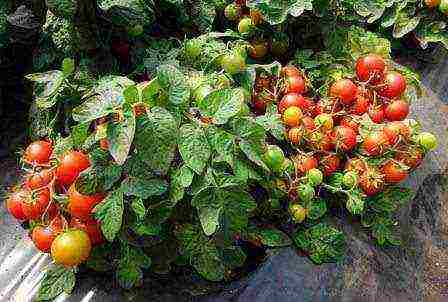 Choosing tomatoes, the best varieties for open ground - undersized, unpretentious and productive - should be looked for in specialized catalogs. There are both promising novelties and tomatoes that have already been tested by gardeners and have received positive reviews. Before buying, you can see the photo and understand how ripe fruits will look like. According to experienced gardeners, compact standard varieties are unpretentious, calmly tolerate temperature fluctuations and rarely get sick.
Choosing tomatoes, the best varieties for open ground - undersized, unpretentious and productive - should be looked for in specialized catalogs. There are both promising novelties and tomatoes that have already been tested by gardeners and have received positive reviews. Before buying, you can see the photo and understand how ripe fruits will look like. According to experienced gardeners, compact standard varieties are unpretentious, calmly tolerate temperature fluctuations and rarely get sick.
Mini bushes: what are their advantages
When choosing tomatoes for open ground, the size of the plants must be taken into account. A great advantage of low-growing tomatoes is compact placement. More plants can be placed on a standard bed, and they will not interfere with each other. Landings are neat and easy to care for.
When deciding which seeds are suitable for the garden, it is important to pay attention to the photo of tomatoes. Low-growing tomatoes can be large-fruited or very small, round, cylindrical, pear-shaped. Some tomatoes ripen in clusters or bunches. The most productive varieties and hybrids should be looked for in specialized catalogs, where there is not only a photo, but also a detailed description with the nuances of agricultural technology.
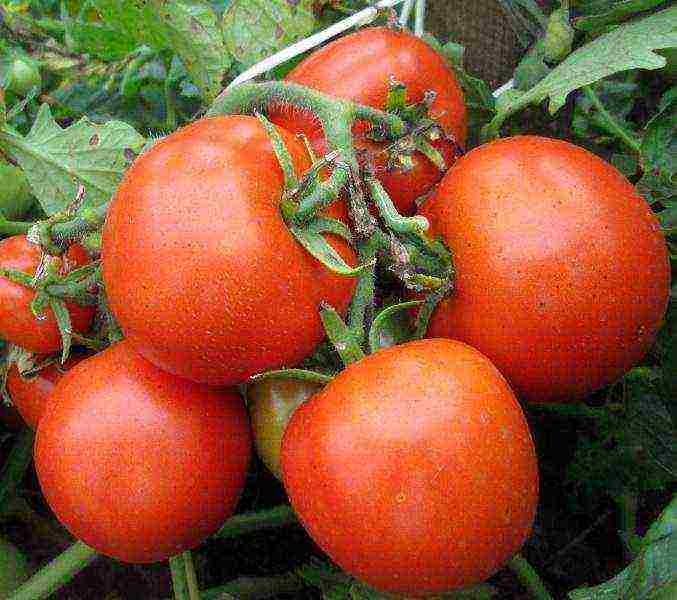
Low-growing tomatoes are often planted in open ground. Their miniature size protects plants from frost, drought and other vagaries of the weather. Most varieties do not need tying, pinching and pinching. If desired, the lower moldings of the tomatoes can be removed, allowing light to reach the ovaries.
A great advantage of undersized tomato varieties is disease resistance. Plants are less often affected by late blight and cladosporium disease, they are resistant to viruses, gray, root or apical rot.
Tomato varieties for open ground (video)
The best varieties for open ground
Promising tomatoes for private households and farms can be found at industry fairs or in catalogs that publish not only descriptions, but also photos of fruits. It is important to buy seeds only from trusted producers who guarantee freshness, high quality and compliance with the declared variety.
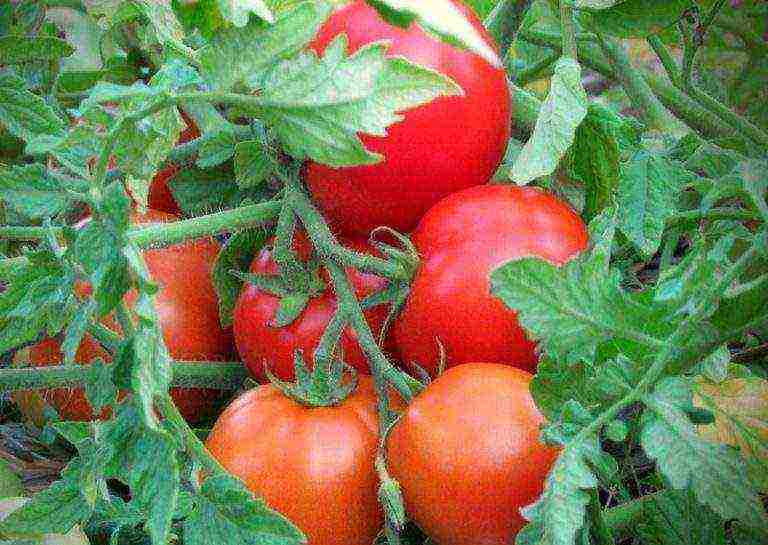
Experienced gardeners recommend considering the following tomatoes:
- Benito. First generation hybrid, fruitful and cold hardy. Compact standard bushes with lush greenery are suitable for planting in open beds, but they feel good under the film. Plants are resistant to viruses and late blight, are rarely affected by pests. Tomatoes ripen together, 6-8 in brushes. Up to 7 kg of selected fruits can be removed from one bush. Tomatoes are very tasty, with sweetish firm pulp and thin skin.
- Snow Leopard. Large-fruited mid-season variety of Russian selection. Prefers fertile soil. The weight of ripe tomatoes varies from 120-140 g, the color is bright, reddish-orange, the taste is pleasantly sweet with a slight sourness. The variety can be grown in any region; on cold nights, the bushes are covered with foil. The ripening period is extended, the fruits are harvested before frost.
- Volgograd Pink.Low-growing tomatoes resistant to the climate of central Russia. They grow well on any soil, but in fertile soil, the fruits are larger. They need minimal maintenance, no pinching is required. Tomatoes are large, of a beautiful pink color, with a delicate bright taste and delicate aroma. Suitable for canning and preparing salads.
- Tarpan. The hybrid of the first generation, has a high yield. From 1 m² of plantings, you can collect 10-12 kg of selected tomatoes. Cold hardy, but in warm climates the fruits are larger. The hybrid is picky about the nutritional value of the soil, prefers frequent feeding. Tomatoes are beautiful, flat-rounded, warm pink. The taste is intensely sweet, the pulp is juicy, sugary at the break.
- Betta. Dwarf tomatoes, the height of the bush does not exceed 50 cm. The variety is resistant to diseases, rarely affected by pests. Suitable for planting in flower beds or large flowerpots. Fruits are medium in size, sweet and juicy. In the process of maturation, the color changes from light green to deep dark red. The dense but not tough skin makes tomatoes suitable for canning.
- Gift of the Volga region. A promising variety of undersized tomatoes of Russian selection. Bushes are low, standard type, with a moderate amount of green mass. Tomatoes of the Dar Zavolzhya variety can have red or pink fruits, the weight varies from 75 to 140 g. On the lower branches, the fruits are larger. The taste is rich, sweetish, the skin of mature tomatoes is thin and glossy. Large tomatoes are eaten fresh, small ones are ideal for whole fruit canning ..
- Japanese Rose. Low-yielding tomatoes, suitable for growing outdoors, in a greenhouse or under plastic. Fruits are richly sweet, fleshy, with few seeds. The short plant, strewn with heart-shaped dark pink tomatoes, looks very elegant. Tomatoes of this variety are popular with children, they are especially tasty when fresh, but they are also suitable for making juices.
- Cranberries in the Sahara. A variety from Russian breeders, suitable for planting in beds or in large pots. Plants are fruitful, after the end of the season they can be brought into the room to lengthen the fruiting period. Tomatoes are medium-sized, very sweet, ripen with beautiful clusters. The taste is slightly sour, spicy. Tomatoes are good for canning in assorted vegetables or baby food.
- Torch. Low growing tomatoes, suitable for growing in cool climates. The bushes are very decorative, they expand from the roots to the top, resembling small torches. Ripe tomatoes are delicious, sweetish with a slight sourness, the flesh is dense and sugary.
Open field tomatoes in Siberia (video)
Growing tomatoes in the beds: gardeners' secrets
Choosing the right seeds is important to maximize the yield of low-growing tomatoes. A tomato grown from material harvested 2 years ago will turn out to be especially successful. Too old seeds with reduced germination should not be used. Before sowing, it is necessary to calibrate and process with a solution of potassium permanganate or hydrogen peroxide. Liquid growth stimulant will help to increase the survival rate. Early varieties of tomatoes are sown in early March or late February, the exact date depends on the region.
Seedlings of low-growing varieties of tomatoes are transplanted to the beds in mid or late May, when the soil warms up enough. The prepared soil can be covered in advance with a film, protecting it from weeds and maintaining a high level of moisture. Before planting, superphosphate, potash fertilizers or birch ash are added to the soil. Old humus or a small portion of peat is also useful. The more nutritious the soil, the sooner the seedlings will start to grow.

Transplanted bushes need to be watered well. In the future, moisture is introduced into the soil 2 times a week, the water should be warm.Cold slows down growth, young plants can shed their ovaries. Caring for bushes of stunted tomatoes is easy. It is limited to timely watering and the introduction of complex fertilizers more often than 1 time per month. Too frequent feeding stimulates abundant growth of green mass to the detriment of fruit formation. Once a season, you can spray the bushes with an aqueous solution of superphosphate, this will accelerate the ripening of tomatoes. Finished fertilizers are often replaced with diluted mullein or chicken droppings.
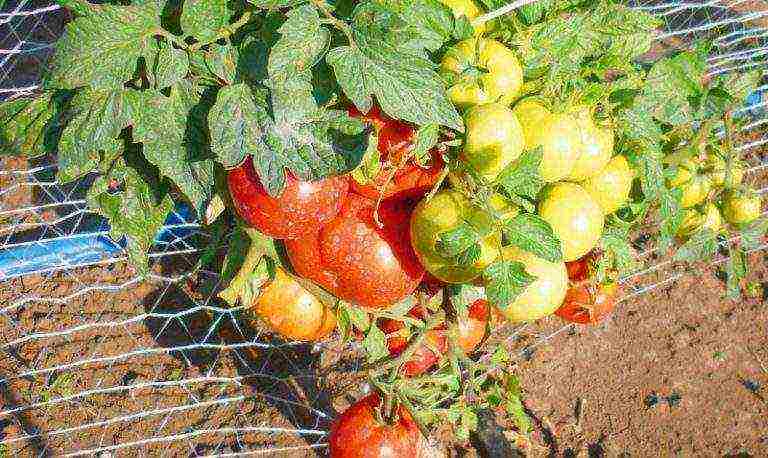
Harvesting takes place throughout the summer. To stimulate new ovaries, you can not wait until the tomatoes are fully ripe and pluck them green. Varietal tomatoes are suitable for collecting seeds, but hybrid bushes will not produce high-quality seed.

Low-growing varieties of tomatoes are an excellent choice for novice gardeners who have not had time to acquire a greenhouse. Plants grow well in open ground, they are not afraid of frost and insect pests. The most productive varieties are unpretentious, caring for them is simple, and the seeds for subsequent plantings can be harvested independently.
Rate the article:
(2 votes, average: 1 out of 5)
